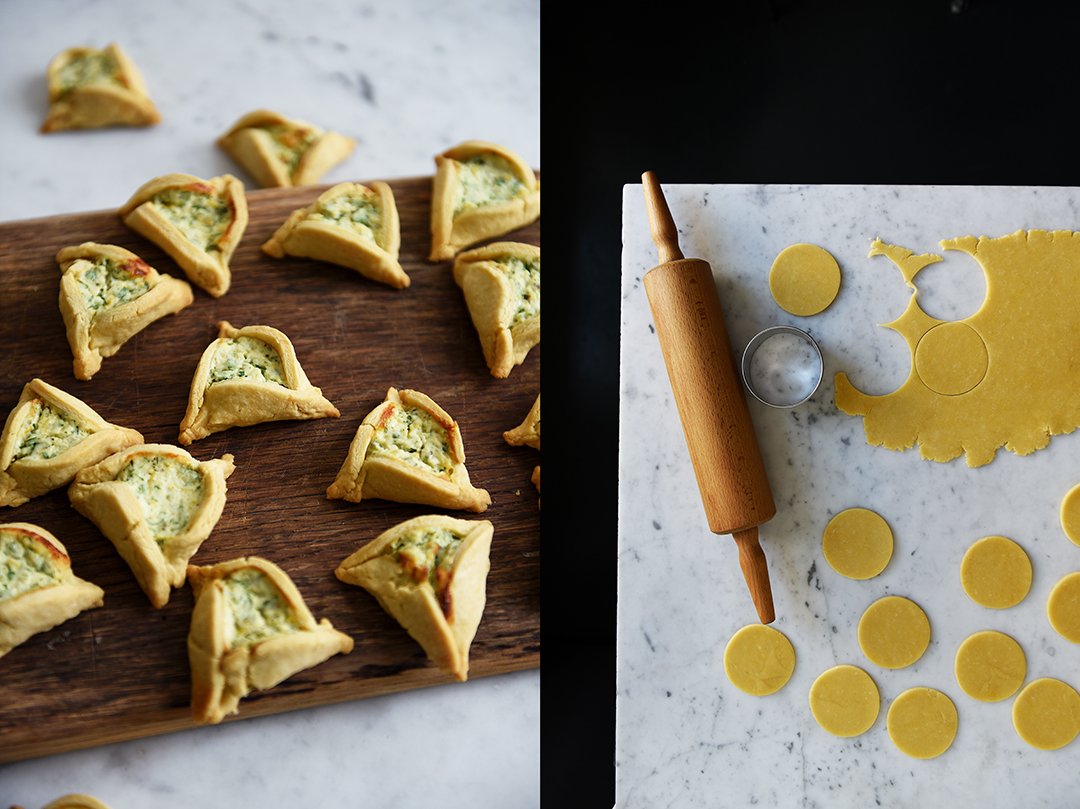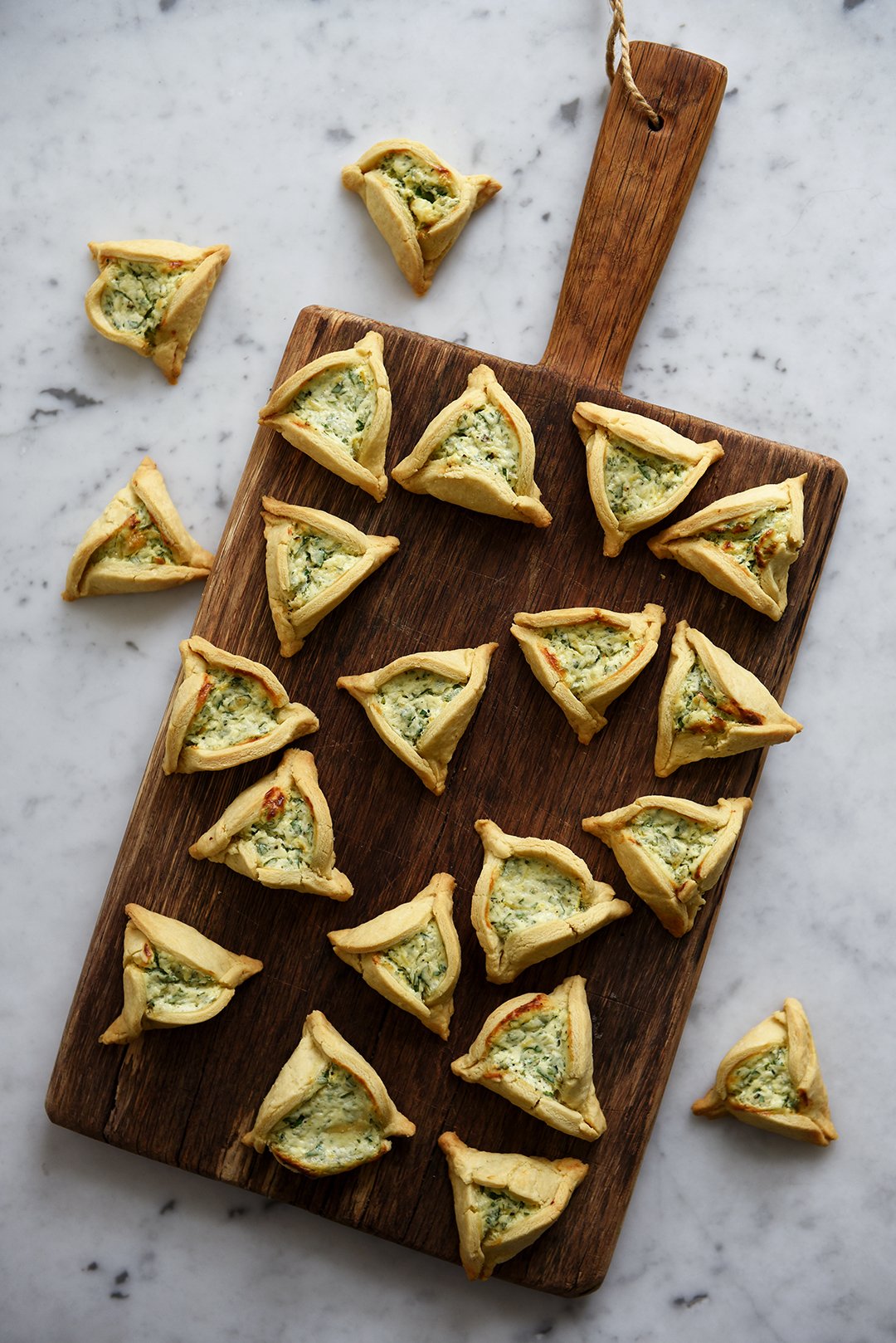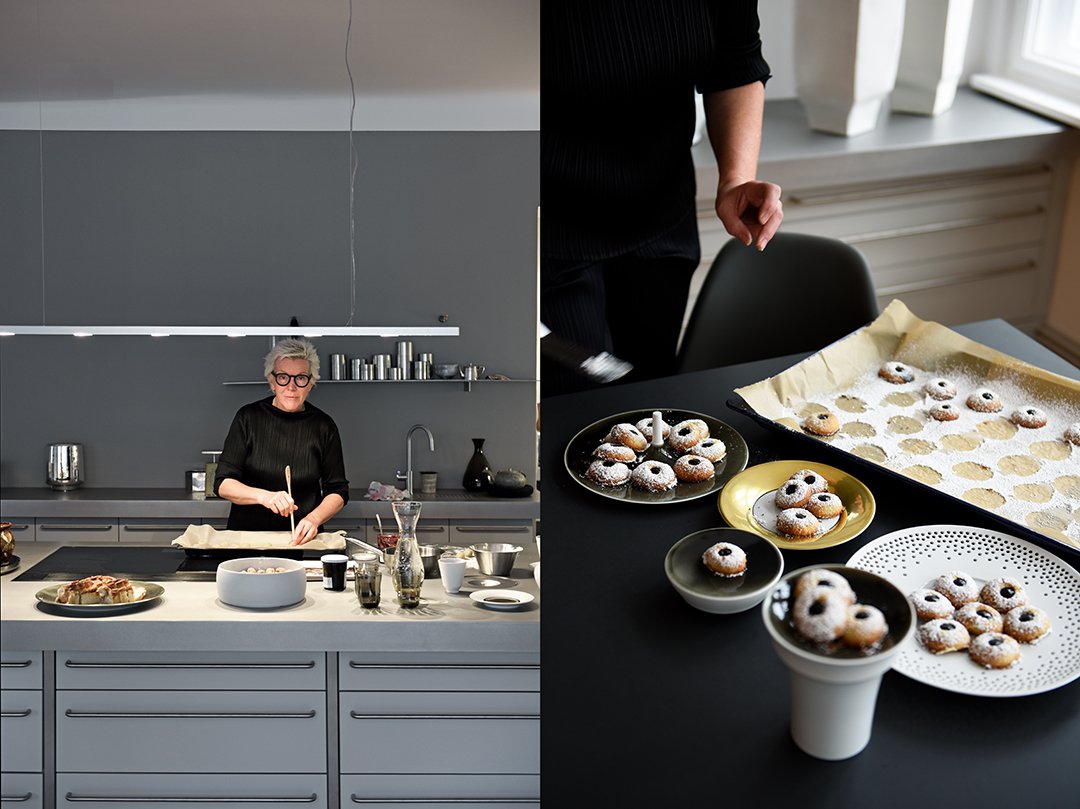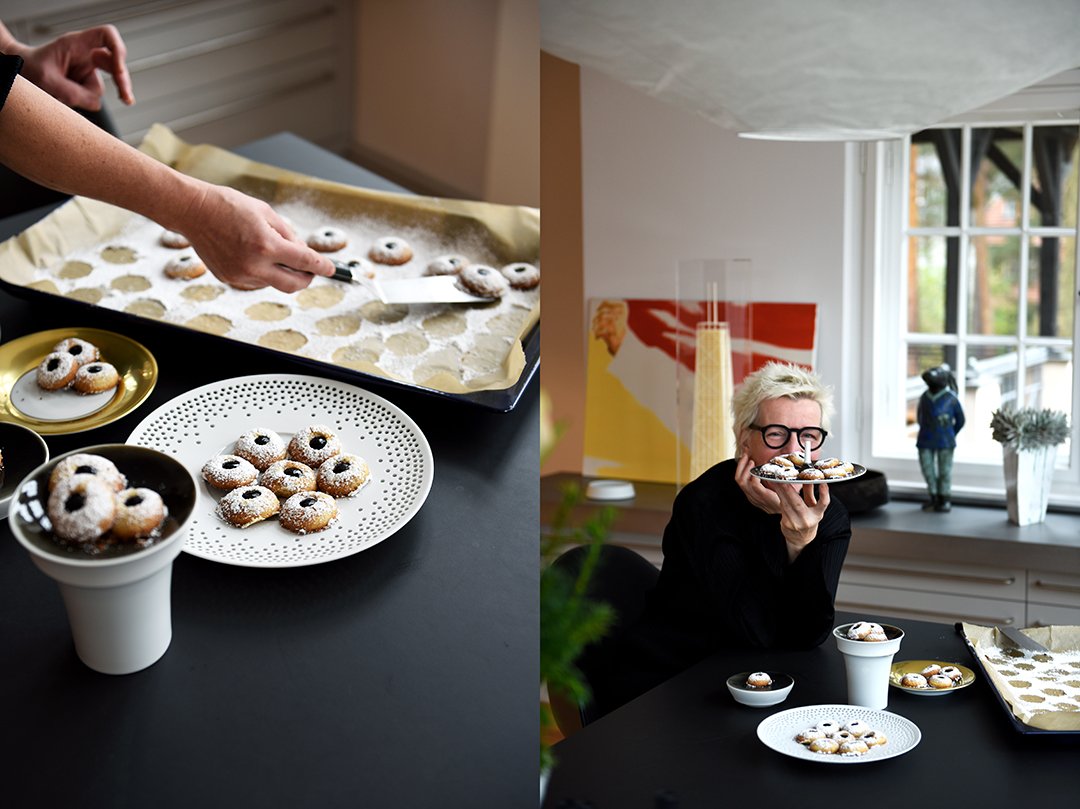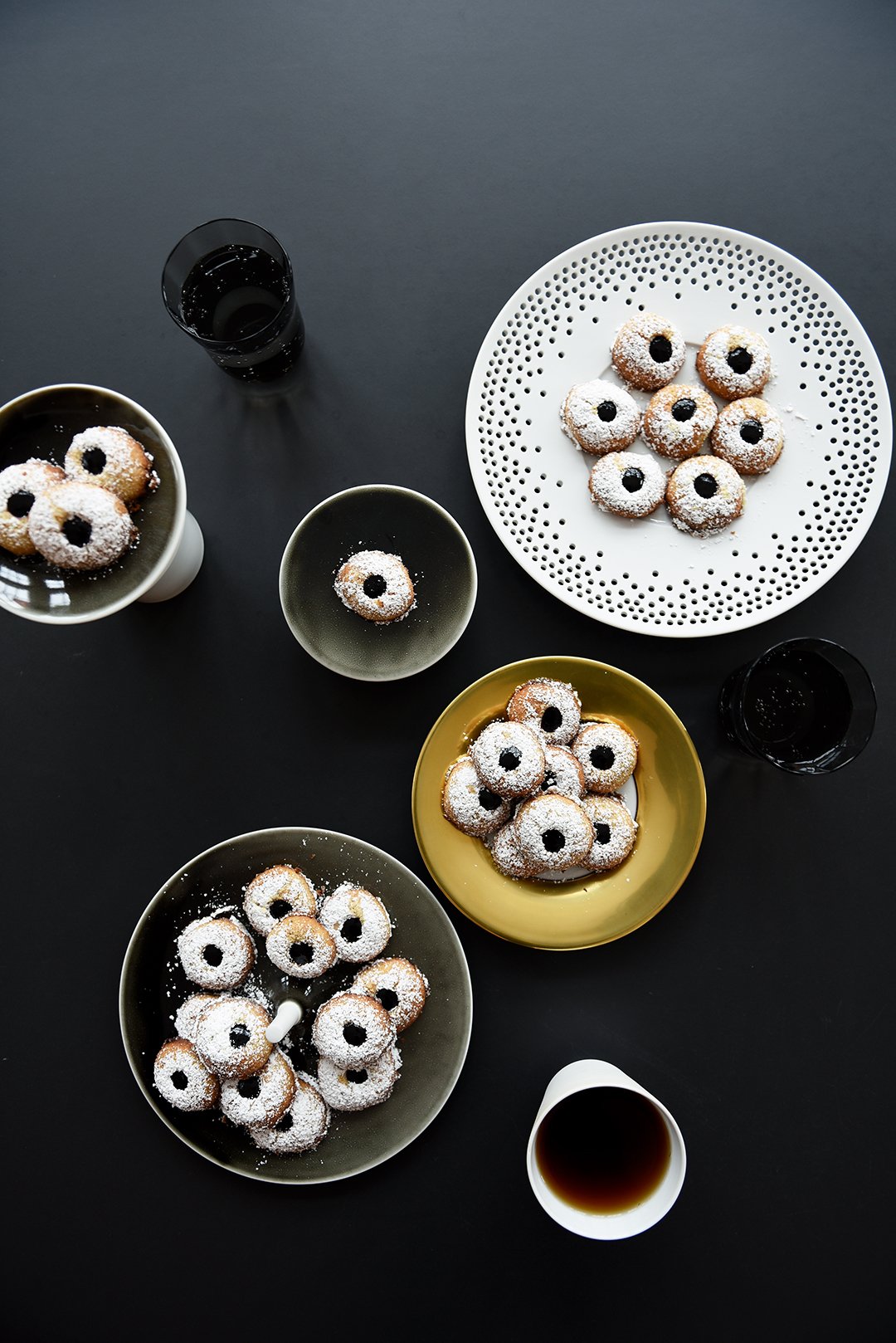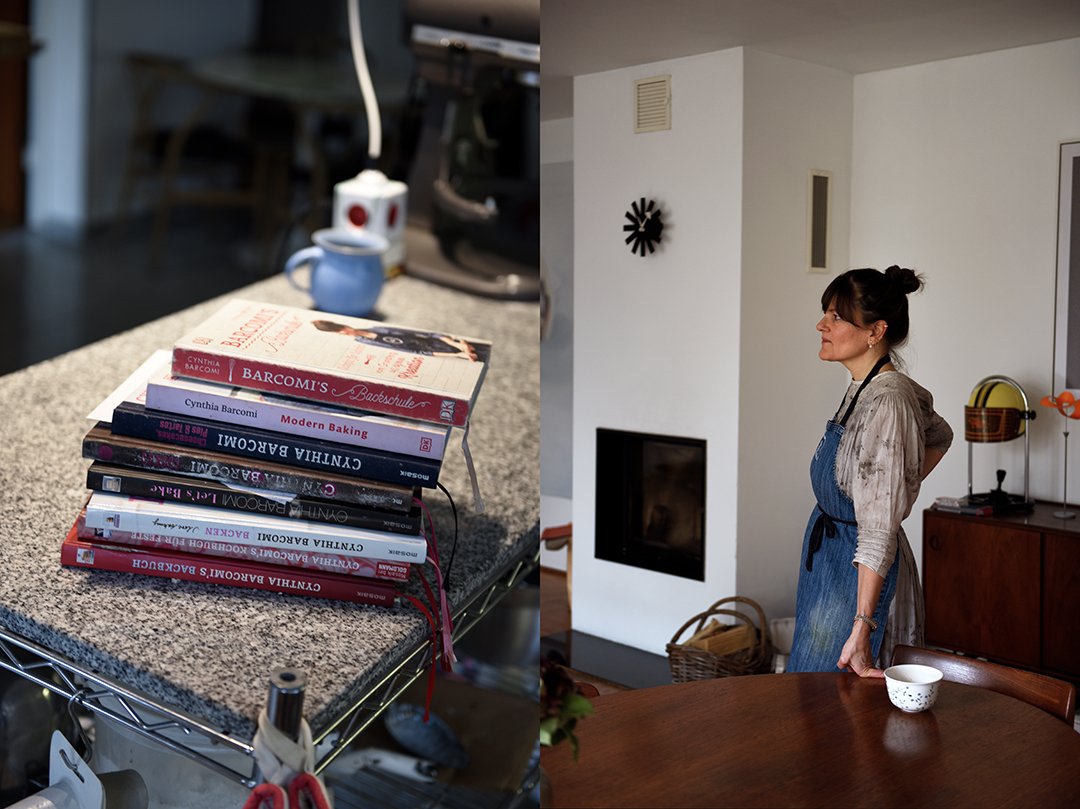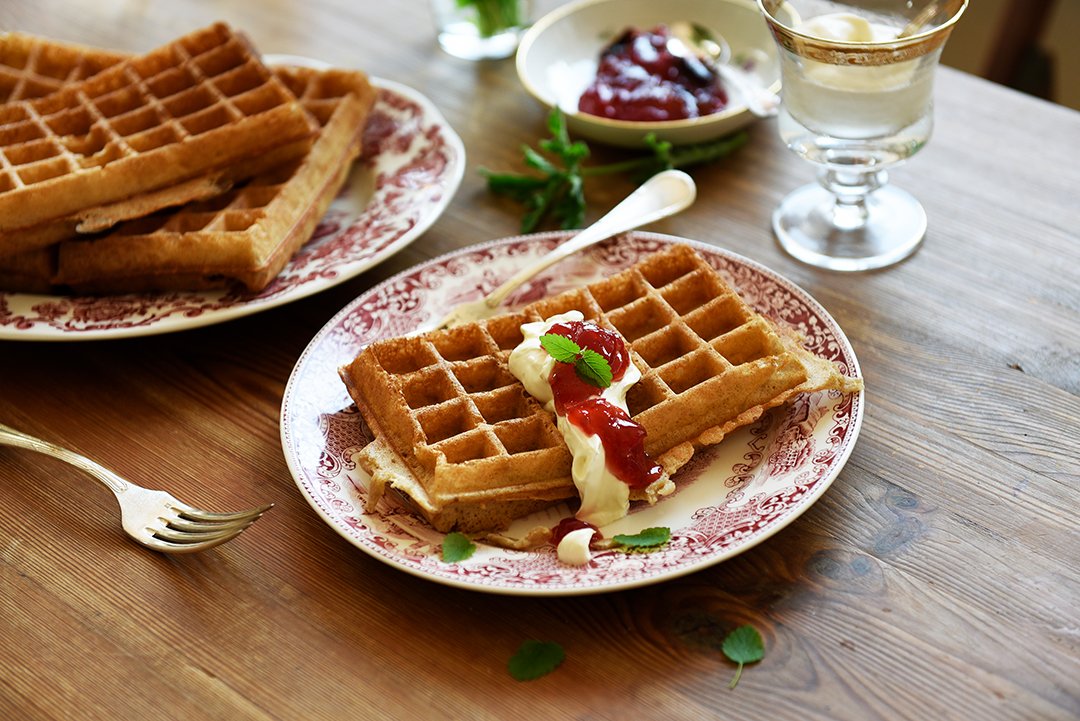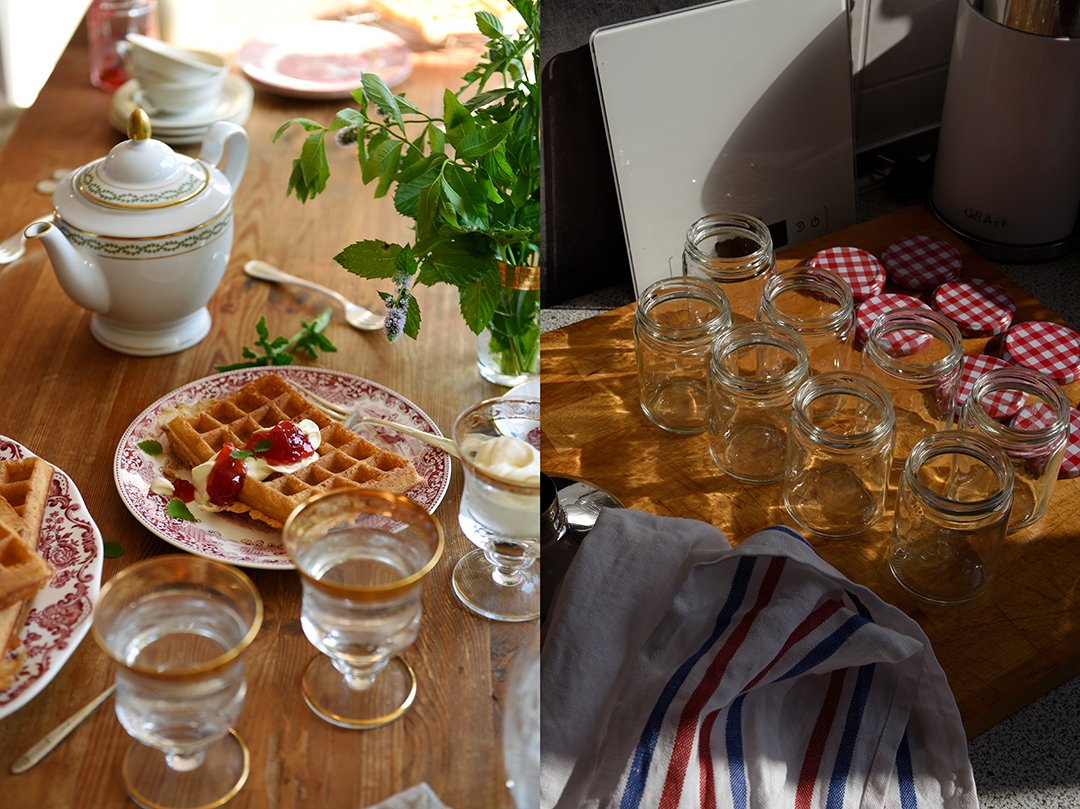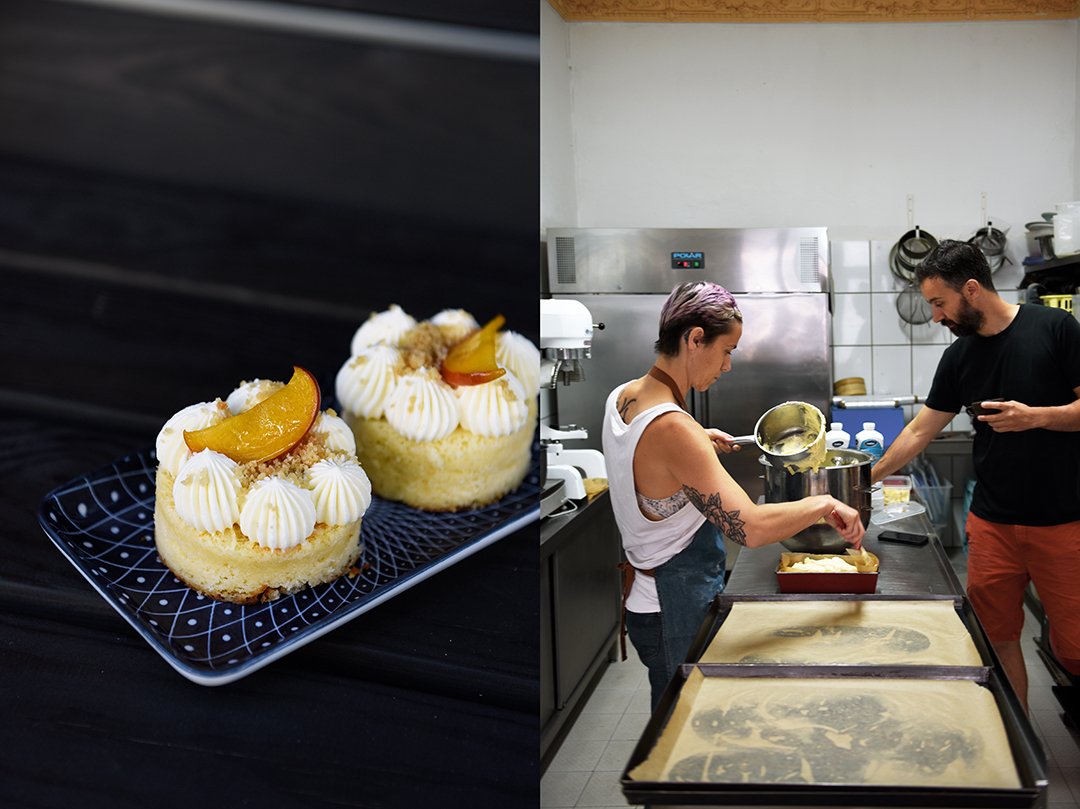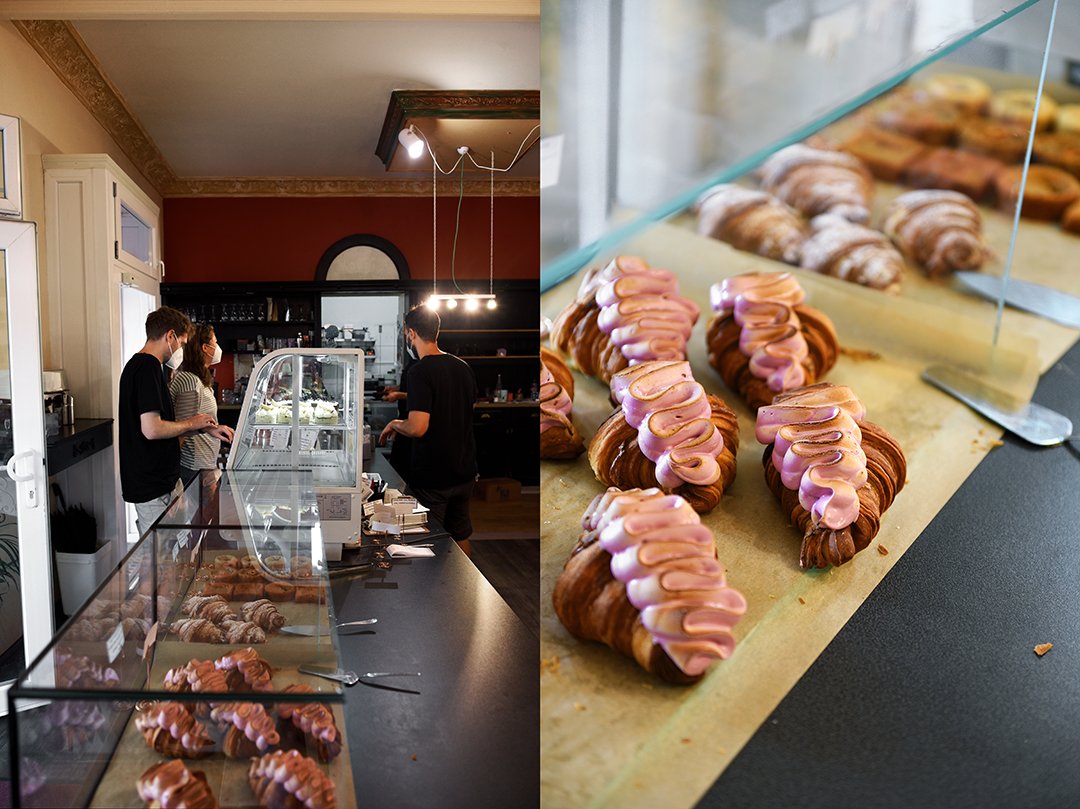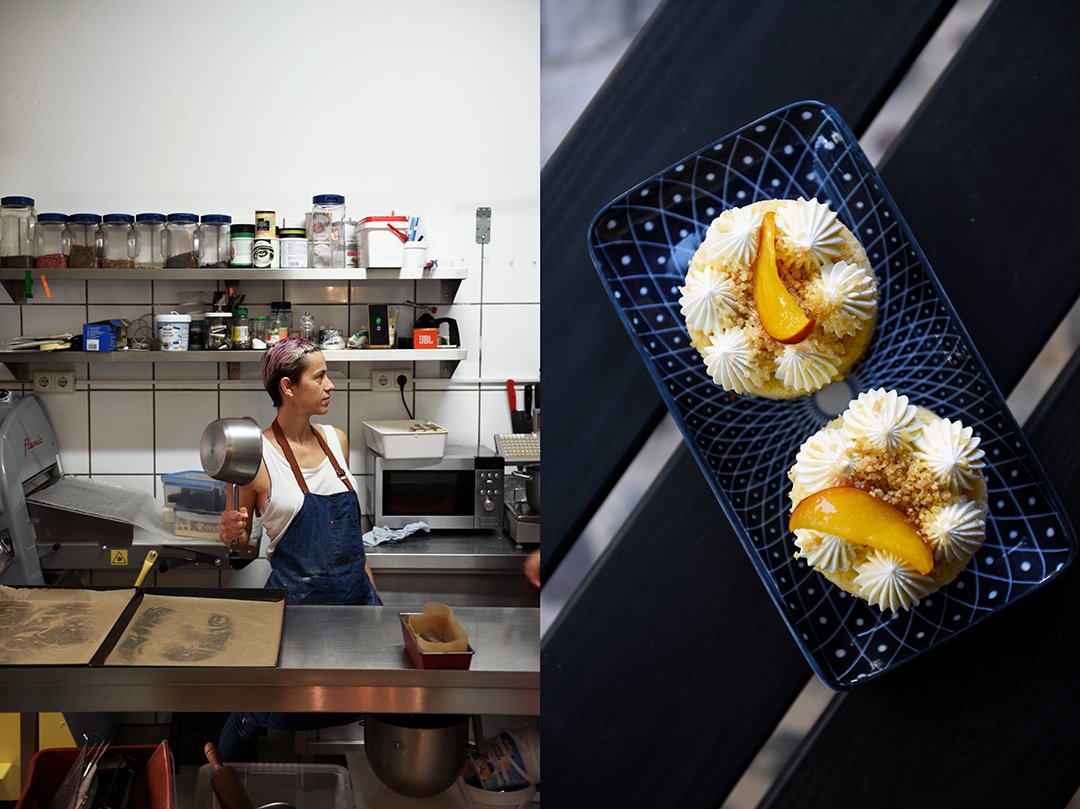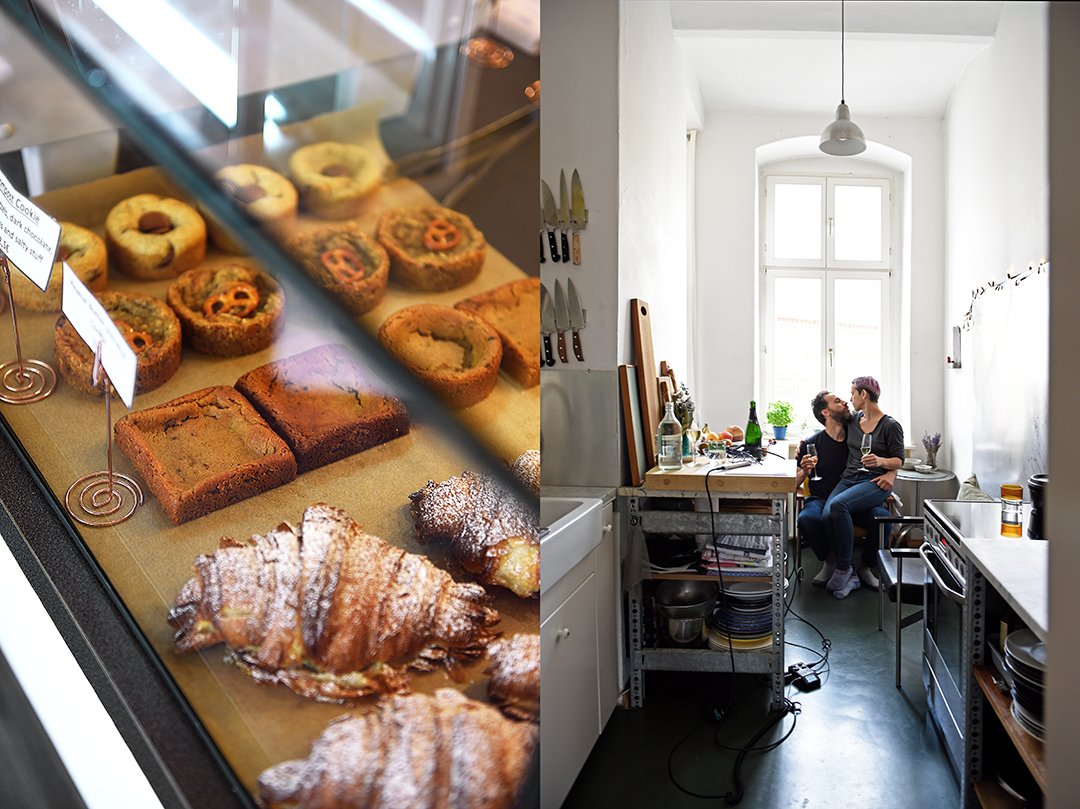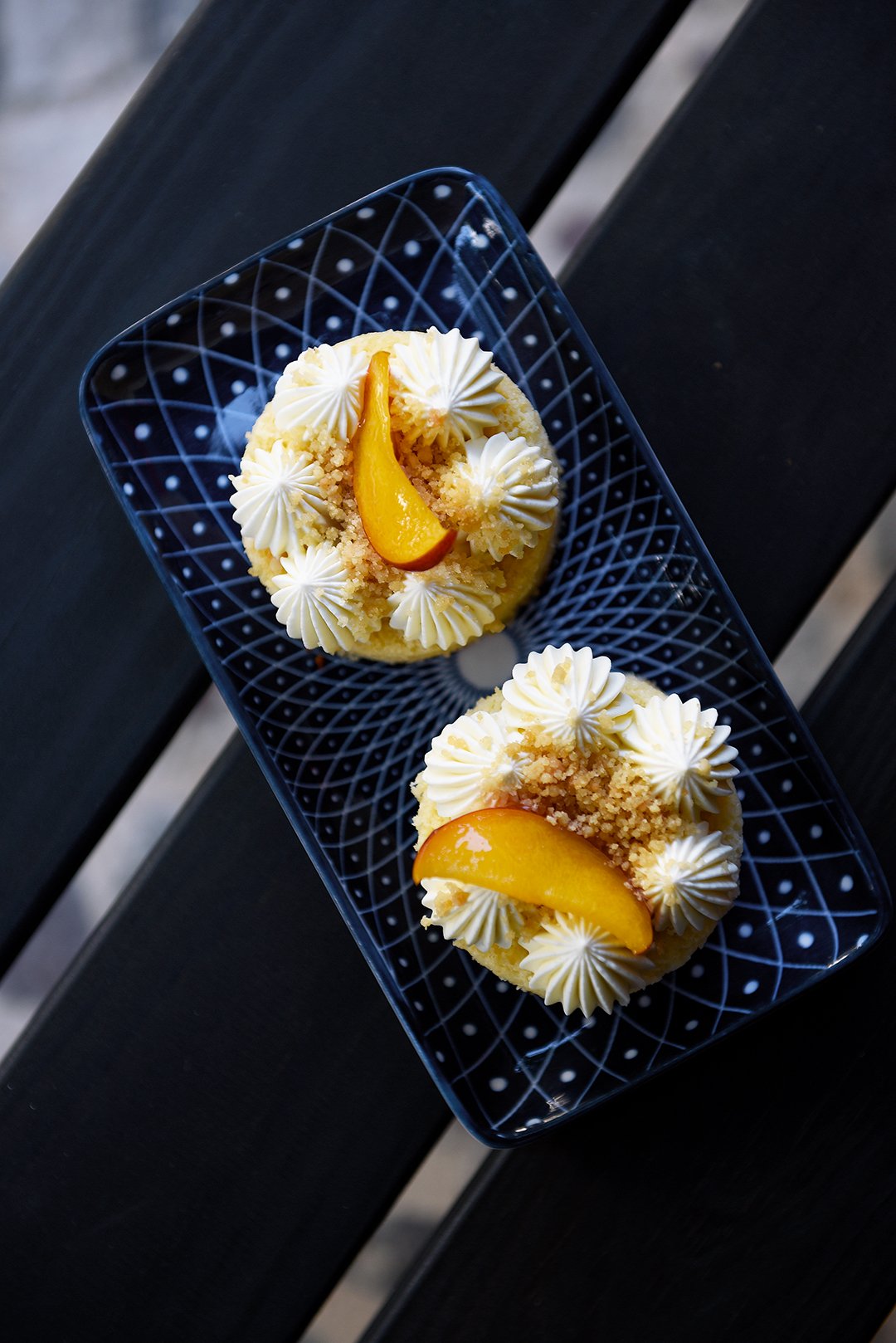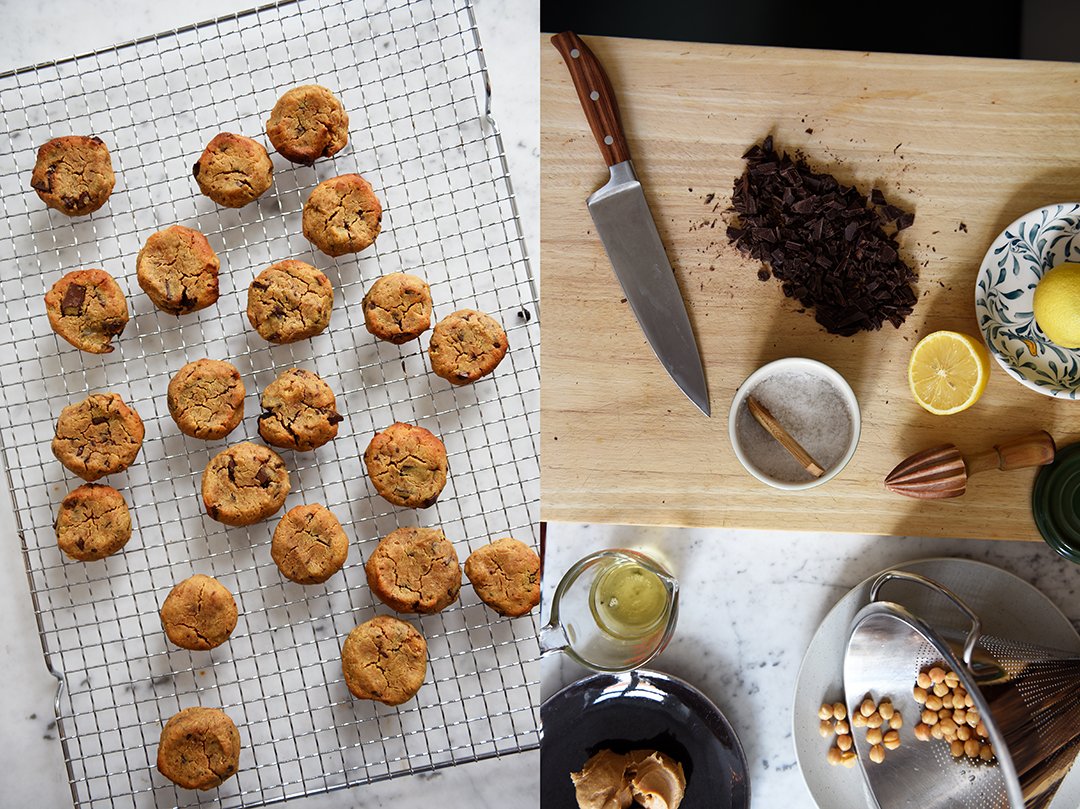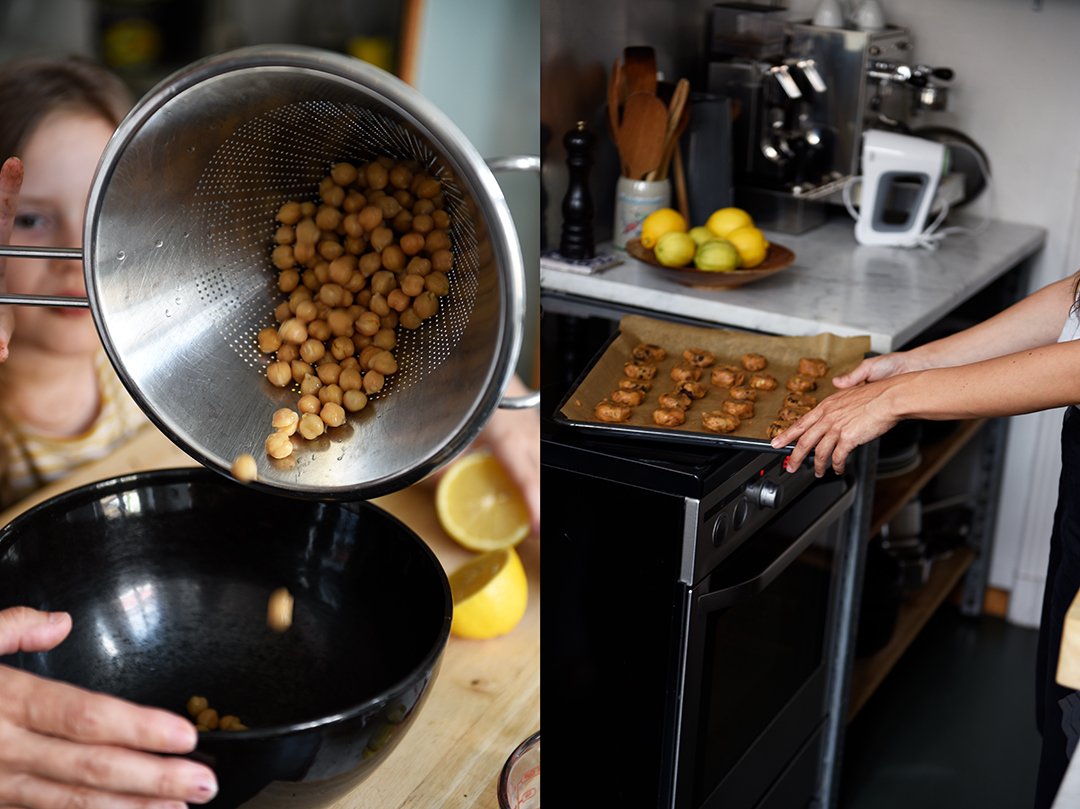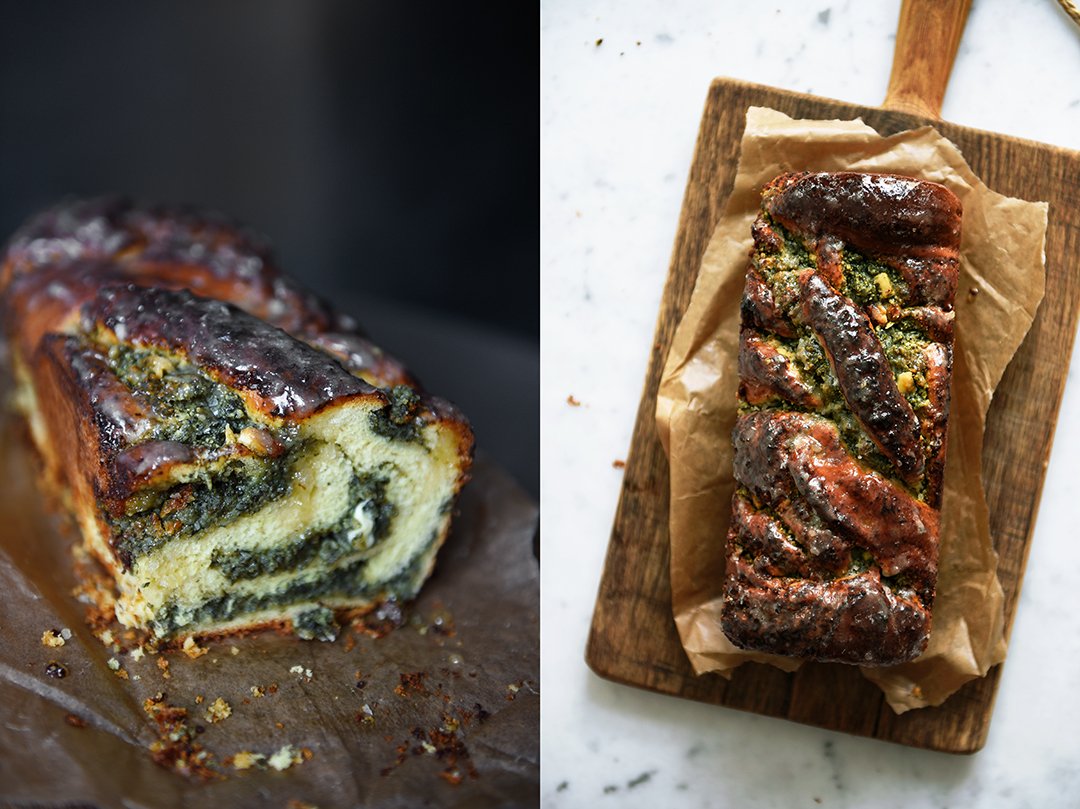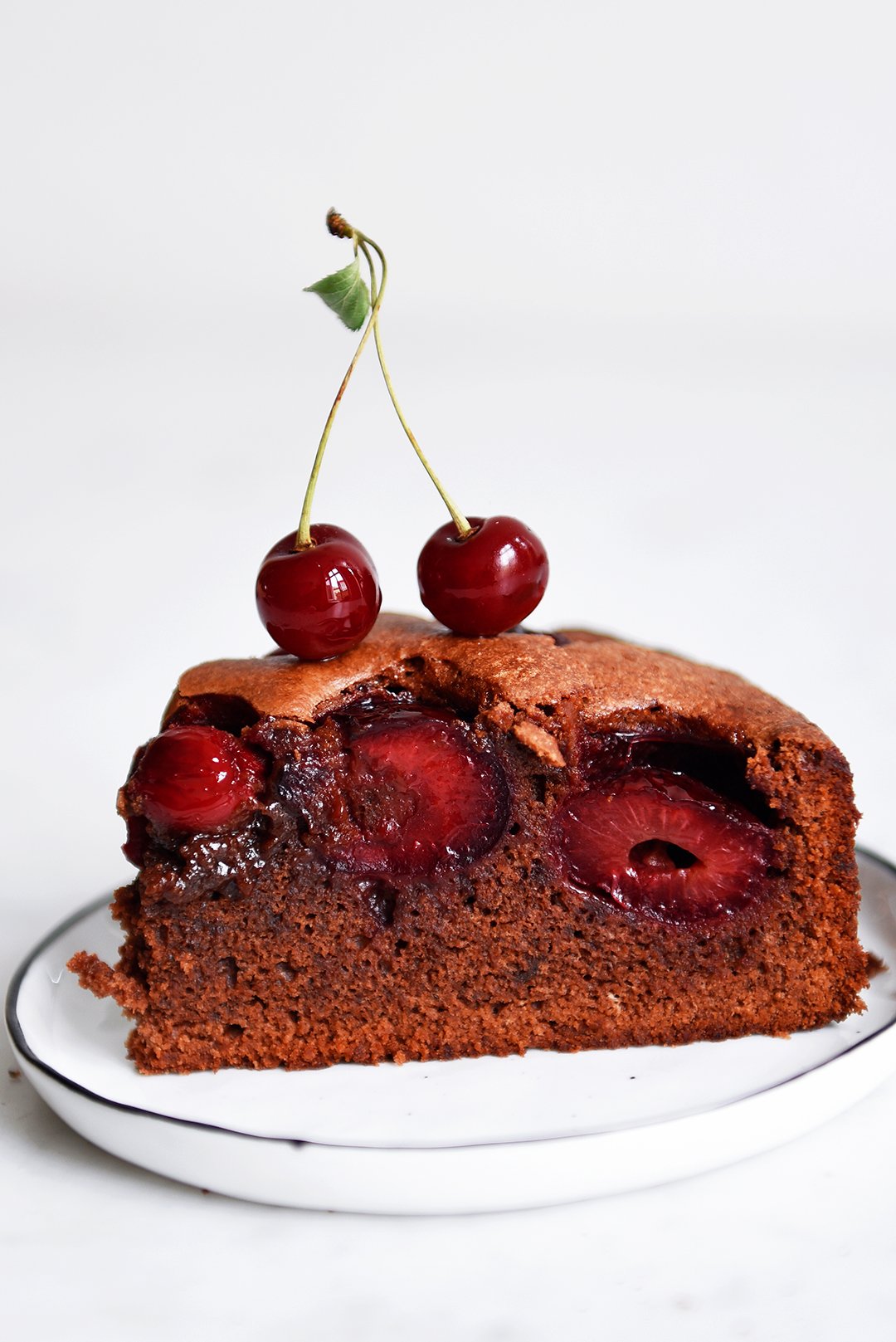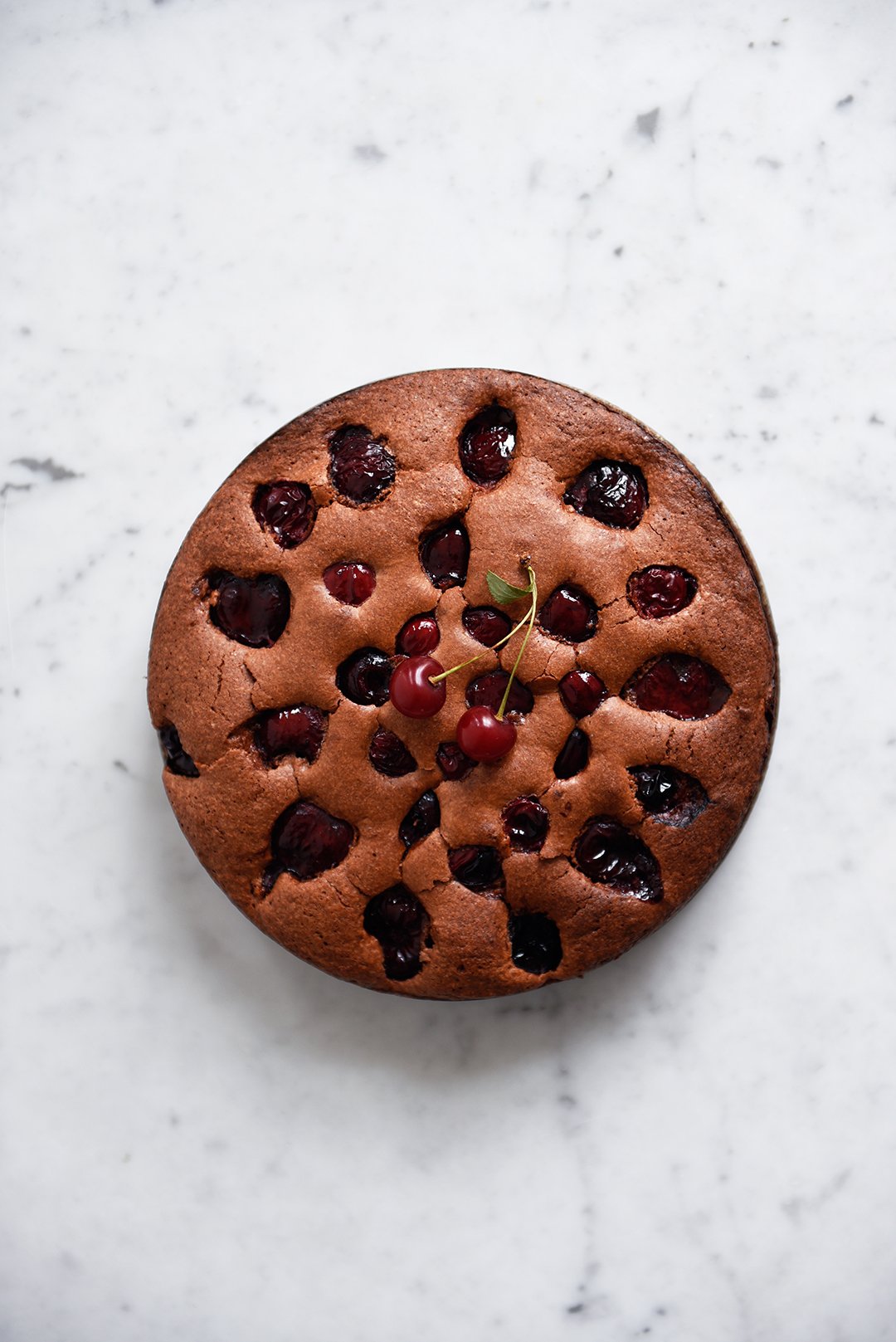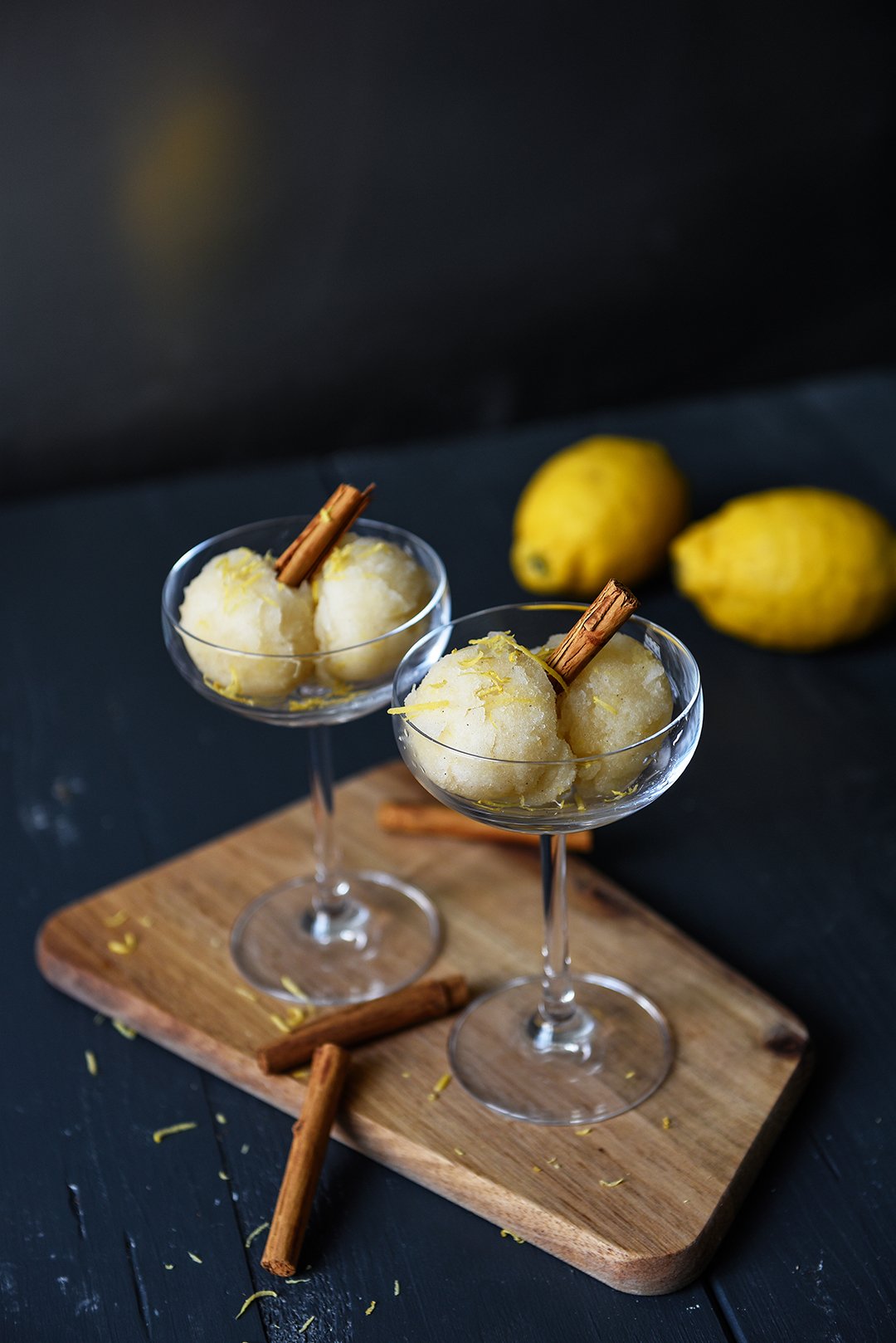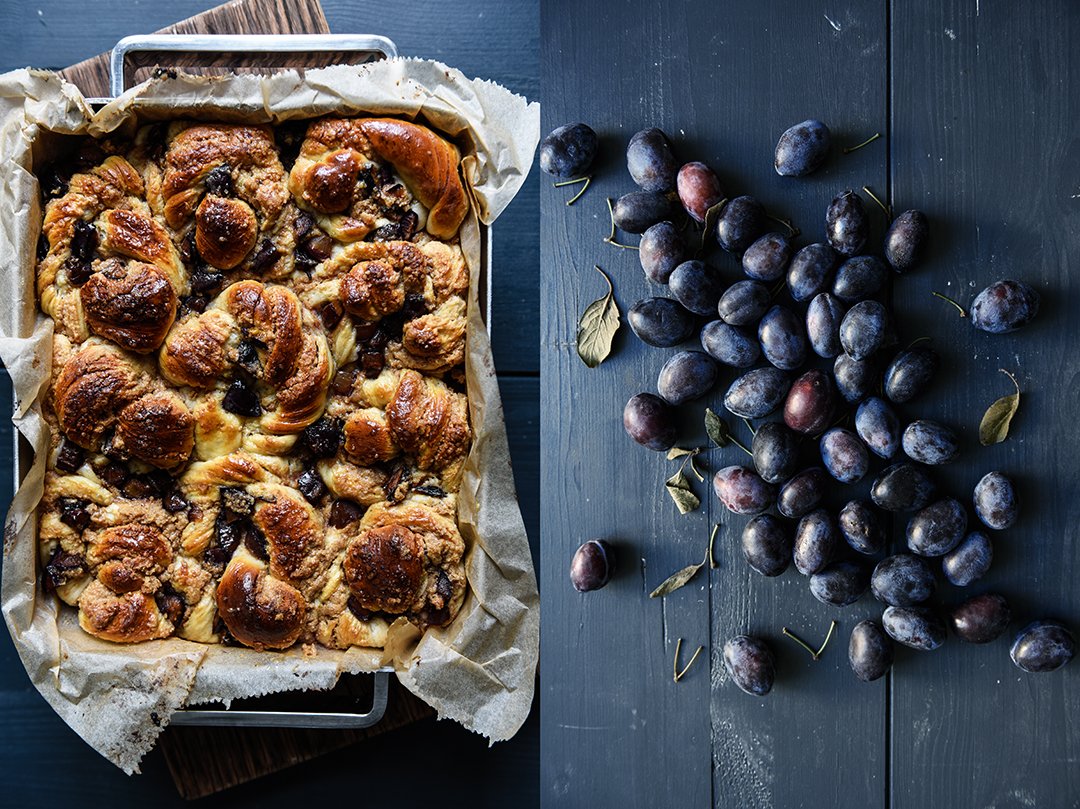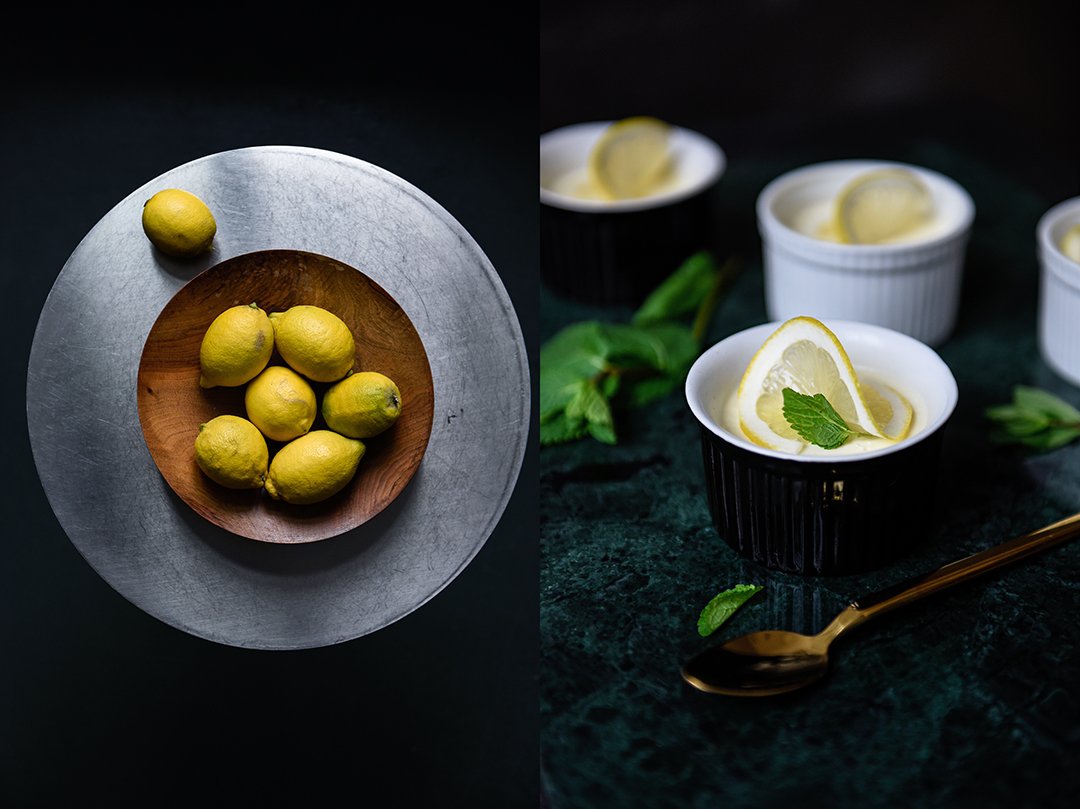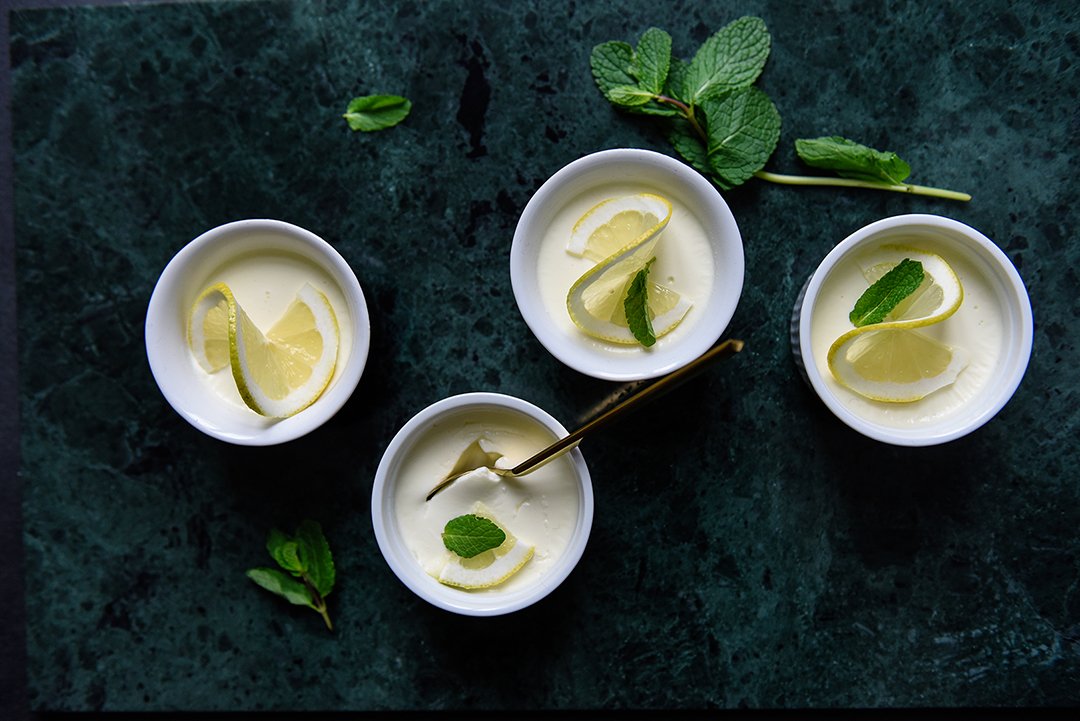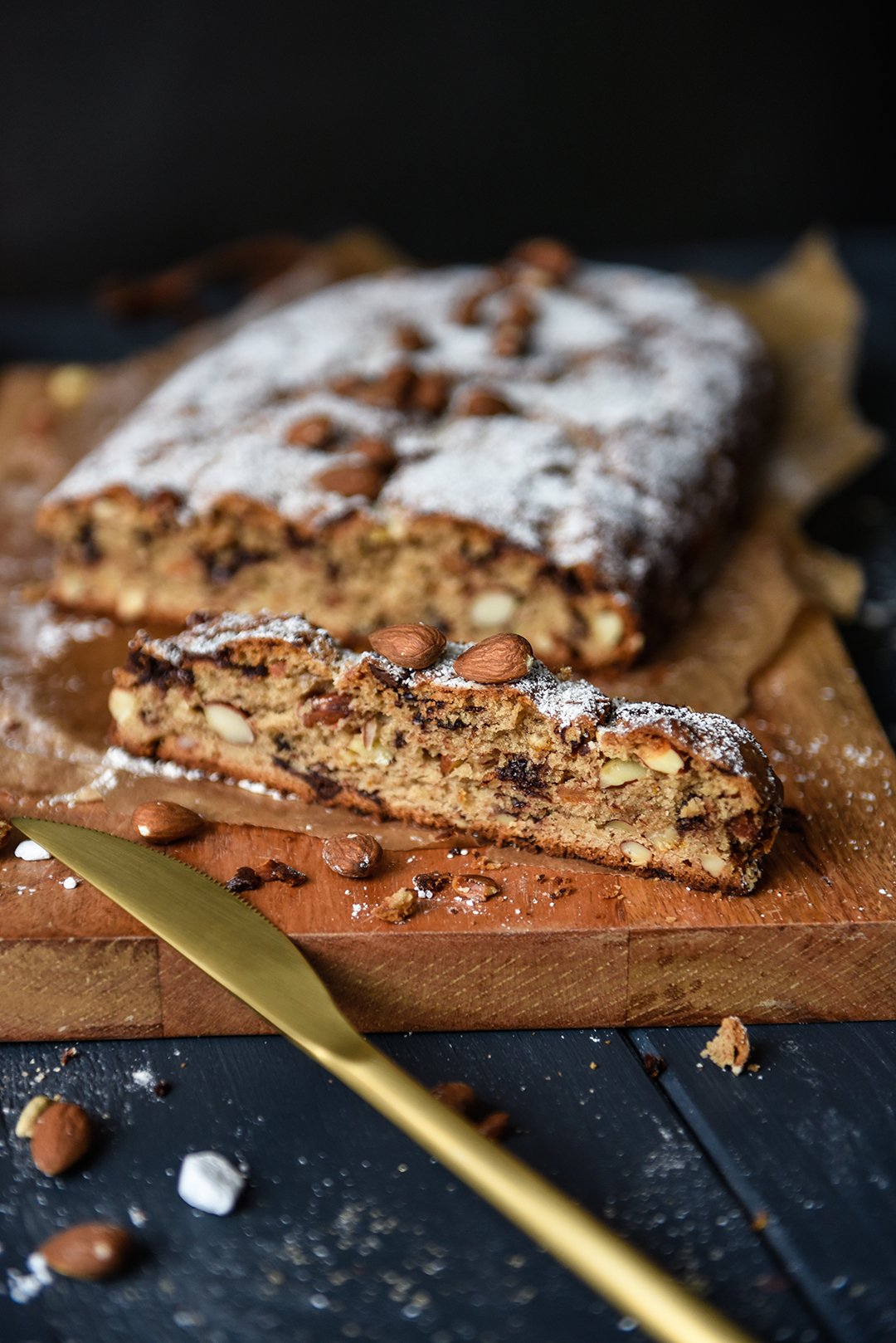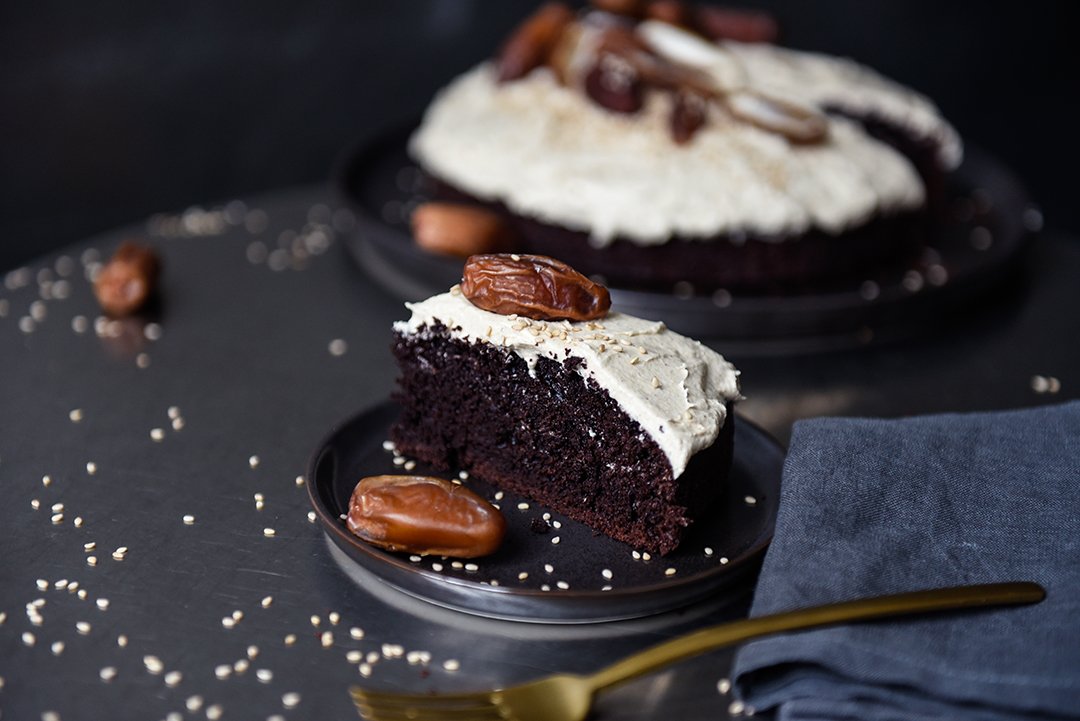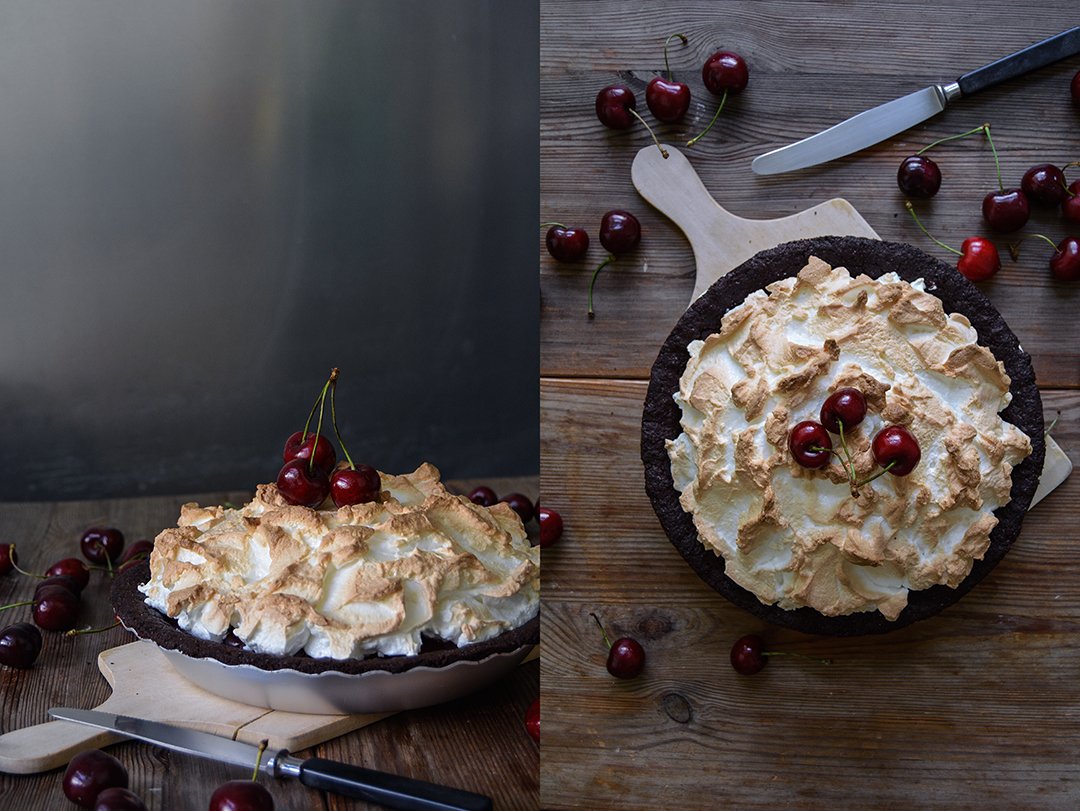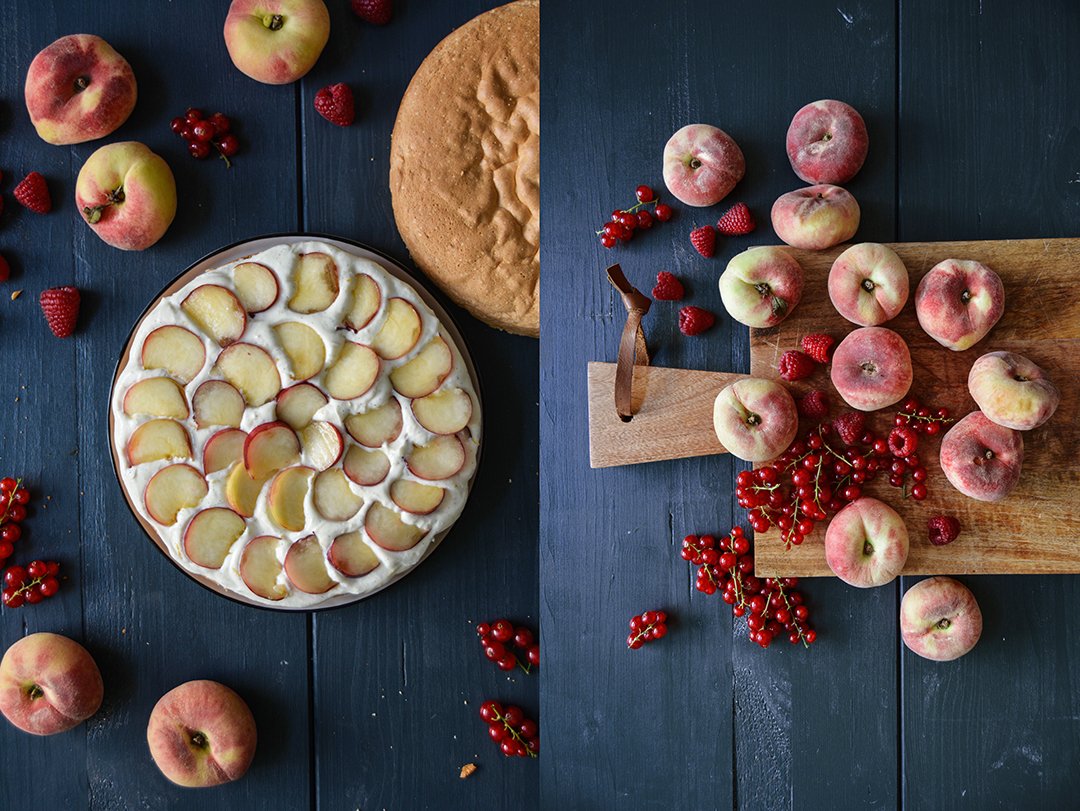Hamantashen with Lemon-Parsley Ricotta
Hamantashen are little pastry pockets, not more than a small bite, usually sweet and filled with poppy seeds, jam, or dried fruit. I turned them into a savory treat with a very lemony ricotta filling refined with lots of chopped parsley. It's a traditional Ashkenazi pastry, baked and shared during the Jewish holiday of Purim, starting this year on the evening of March 16th and ending 24 hours later. So why am I baking them? And why now?
My friend, the Berlin-based American baker Laurel Kratochvila of Fine Bagels spontaneously started Hamantashen for Ukraine, a show of worldwide bakery solidarity for the people of Ukraine. Profits of the sales are being donated to the Polish Humanitarian Action to help and support Ukrainian refugees at the Polish border. Laurel and her bakery friends will bake and sell hamantashen between now and March 17th, the 14th day of the Hebrew month of Adar. To find out where you can buy the charity pastries click here for the ever expanding list of participating bakeries all over the world.
Purim is celebrated to remember the saving of the Jewish people - thanks to queen Esther - from Haman, a vizier of the First Persian Empire who wanted to kill all Jews in the empire. Traditionally, food, drinks, and gifts are shared on this holiday, hamantashen are enjoyed together in the community, donations are given to the poor, and children and adults alike dress up in costumes. Maybe most importantly, these days there's often a reflection on modern day Hamans in the world. That's where this fundraiser comes in.
Laurel shared her recipe for sweet hamantashen with poppy seeds with me and I'll share my first attempt to bake hamantashen with you. Not sweet but packed with lemon-parsley ricotta.
Thank you, Laurel!
Hamantashen with Lemon-Parsley Ricotta
Makes 22 hamantashen
For the pastry
285g / 2 1/4 cups all-purpose flour
1 teaspoon fine sea salt
120g / 1/2 cup plus 1 teaspoon unsalted butter, cold
1 large egg
For the filling
125g / 4.5 ounces fresh ricotta, drained
1 large egg
30g / 1 ounce Parmesan, finely grated
1 small bunch fresh flat-leaf parsley, leaves only, finely chopped
1 scant tablespoon freshly grated lemon zest
1/4 to 1/2 teaspoon fine sea salt
Coarsely ground pepper
For the pastry, combine the flour and salt in the bowl of a stand mixer fitted with the paddle attachment. Add the butter and use a knife to cut it into the flour until there are just small pieces left. Quickly rub the butter into the flour with your fingers until combined. Add the egg and briefly mix with the paddle until crumbly. Form the dough into a thick disc, wrap it in plastic wrap, and chill in the fridge for 1 hour.
Preheat the oven to 180°C / 350°F (preferably convection setting). Line a baking sheet with parchment paper.
For the filling, whisk together the ricotta, egg, Parmesan, parsley, lemon zest, 1/4 teaspoon salt, and a generous amount of pepper in a medium bowl. Season to taste with additional salt.
On a work surface, place the dough between 2 sheets of plastic wrap and use a rolling pin to roll out until it’s about 3mm / 1/8 inch thick. Using a 7cm / 3 inch round cookie cutter, cut out circles, re-rolling any pastry scraps. Place 1 teaspoon of the filling in the middle of each circle. To shape, fold 3 sides inward to make a triangle, either overlapping or pinching where the edges meet. Transfer to a large platter and chill in the fridge for 10 minutes.
Transfer the hamantashen to the prepared baking sheet and bake for about 18 minutes or until the pastry is golden and just baked through. Let them cool for a few minutes and enjoy!
______________________________
Hamantashen with Poppy Seeds
by Laurel Kratochvila / Fine Bagels
Makes 40 hamantashen
For the pastry
440g / 3 1/3 cups all-purpose flour
240g / 1 cup plus 1 teaspoon unsalted butter, cold, cut into cubes
130g / 1 cup plus 1 tablespoon finely ground almonds
120g / 1 cup confectioners sugar
1/4 teaspoon fine sea salt
2 large egg, beaten
1 teaspoon vanilla extract
For the filling
150g / 1 1/2 cups ground poppy seeds
75g / 1/3 cup plus 1 tablespoon granulated sugar
210ml / 3/4 cup plus 3 tablespoons whole milk
2 teaspoons unsalted butter
1/2 lemon, juice only
2 tablespoons honey
For the pastry, in the bowl of a stand mixer fitted with the paddle attachment, mix the flour and butter on low speed until sandy in texture, no bits of butter remaining. Add the ground almonds and confectioners sugar and mix until well combined. Add the salt, eggs, and vanilla and mix on low until the dough has just come together and no dry bits remain. Press the dough into a thick disc, wrap it in plastic wrap, and chill in the fridge for 2 hours or up to 48 hours.
For the filling, in a heavy, medium saucepan, bring the poppy seeds, sugar, milk, butter, and lemon juice to a gentle boil over medium heat. Reduce the heat to low and simmer until thickened. Remove from the heat, stir in the honey, and let cool completely before using. Covered airtight, you can refrigerate it for up to 1 week.
Preheat the oven to 170°C / 340°F. Line a baking sheet with parchment paper.
To use the chilled pastry, you must break it: Fold it in half and roll it out once. It will crack. Fold the dough back up and roll out a second time. Now it's ready.
On a work surface, place the dough between 2 sheets of plastic wrap and use a rolling pin to roll out until it’s about 3mm / 1/8 inch thick. Using a 7cm / 3 inch round cookie cutter, cut out circles, re-rolling any pastry scraps. Place 1 teaspoon of the filling in the middle of each circle. To shape, fold 3 sides inward to make a triangle, either overlapping or pinching where the edges meet. Transfer to a large platter and chill in the fridge for 20 minutes.
Transfer the hamantashen to the prepared baking sheet and bake for about 15 minutes or until the pastry is golden and just baked through. Let them cool for a few minutes and enjoy!
Meet in Your Kitchen | Kristiane's Kaiserschmarrn, Pars and Pralinés
This post is part of my Meet in My Kitchen podcast: How did we get to where we are in life & what does food have to do with it
"I thought I wasn’t allowed to do something that was different from what I had learned. I felt trapped in the traditional framework of the patisserie. I was very nervous to dive into a new scene where I felt I didn’t belong to." - Kristiane Kegelmann
Whenever we create something we use our senses. No matter if it's about the arts or crafts, we see, we feel, we smell, and when it comes to food, we also use our taste. Kristiane Kegelmann loves working with the whole sensory spectrum, in her art and in the food she creates - and especially when they both merge.
During her early years as a pastry chef in Vienna, at the traditional Demel confectionery founded in 1786, Kristiane often pushed the boundaries of her craft. Although the budgets for customized cakes, torten, and gateaux were often almost bottomless, the freedom, the expectation of how a sweet creation should look like was limited. In size larger than herself, the costs sometimes reaching the price of a small car, yet her creativity was forced to stay within a certain range, the rigid range of the classic patisserie, of its craft and creations, defined over hundreds of years.
There was no tolerance when her aesthetic feeling, and her curiosity, left the frilly cream toppings and sugary ruffles and roses behind. Kristiane likes cubistic shapes reminding of the concrete architecture of the 60s and 70s, of brutalism, Le Corbusier and Gottfried Böhm, or the angular shapes of Daniel Libeskind's buildings. Her approach is far from sweet, cute, and superficially pleasing. Her aesthetic is definitely challenging for the stubborn pastry traditionalist.
It was only through the arts that she felt able to free herself, to go beyond her own expectations in her craft. Working with an Austrian sculptor, experimenting with architectural forms and structures, combining edible and non-organic material both in her art and in her pastries and chocolates, and in the end leaving Vienna to move to Berlin, were the necessary steps to become the artist and pâtissière she wanted to be.
"Chocolate allowed me to fill a shape with a surprise. I felt, seeing that this is what I’m good at, I’m allowed to turn it into art." - Kristiane Kegelmann
Growing up in Munich in a family where food in general, but each ingredient in particular, was given a lot of attention, a huge effort was made to strive for quality and track the origin of the products that ended up in her mother's kitchen. Kristiane knew about buckwheat - and wasn't particularly fond of it - when the other kids were still munching on soft wheat bread sandwiches with flappy cheese. Her sense for flavors, for quality, started to become more and more refined even before she became aware of it.
Arriving Berlin in 2015, all of a sudden Kristiane had all the freedom, and the space, to create art and food according to her own ideas. Some of her works are edible, like her chocolates and pralinés, some aren't, which turned into a new conflict: where are the two disciplines interwoven, where shouldn't they, where does one start and the other one end? It's an ongoing process and the price you pay for creative freedom.
"In our traditional food, we used to be much closer to the original produce than we are today. It’s a process of simplification, of industrialization." - Kristiane Kegelmann
At least at her pars pralinés shop, you can eat everything the pastry chef puts in front of you - and that is spectacular. Kristiane puts the same attention into her sweet creations' fillings as she puts into their shapes and (natural) coloring. Once you bite into the delicate chocolate shell, you might be surprised by a fragile crunchy dill flower, or pear combined with sesame - which is a fantastic combination. Hops and lavender also go very well together, and a classic hazelnut praliné impresses with the intense, pure taste of hazelnuts that come from Kristiane's home region, from Bavaria.
We would have loved to share a praliné recipe with you but unfortunately, the preparation is too complex, so instead we went for a very comforting Austrian breakfast/ brunch/ teatime/ dessert classic: kaiserschmarrn - a torn pancake - with hazelnuts and apple purée.
The podcast episode with Kristiane Kegelmann is in German. You can listen to the Meet in My Kitchen podcast on all common podcast platforms; there are English and German episodes. You can find all the blog posts about these podcast episodes including my guests’ recipes here on the blog under Meet in Your Kitchen.
Listen to the podcast episode with Kristiane on:
Spotify / Apple / Deezer / Google / Amazon / Podimo
On Instagram you can follow the podcast @meetinmykitchenpodcast!
Kaiserschmarrn with Hazelnuts and Apple Purée
by Kristiane Kegelmann / pars
Kristiane uses her own pure hazelnut spread (Nussmus) for serving, which you can buy online from her shop, but you can of course replace it with any other quality hazelnut spread (although hers is particularly delicious!).
She refines the apple purée with cherry blossom sugar (fresh cherry flowers mixed with sugar and stored in a jar, it's divine!) but you can also use regular sugar.
Serves 4
For the cherry blossom sugar (optional)
1kg / 5 cups granulated sugar
1 handful fresh cherry blossoms
Combine the sugar and cherry blossoms, rubbing the sugar and blossoms with your hands to intensify the flavor, and store in a large jar.
For the apple purée
50g / 1/4 cup cherry blossom sugar (or granulated sugar)
120ml / 1/2 cup apple juice
4 medium, sour, firm apples, cored and cut into small pieces (don't peel the apples)
In a large pan, caramelize the sugar over medium heat then add the apple juice and stir until the caramel dissolves. Add the apples and cook until soft then sweeten with sugar to taste. Using a blender or a blender stick, purée the apples until smooth. If you prefer the apple purée a bit thicker, transfer it to the pan and cook, stirring constantly, until it reaches the desired texture.
For the kaiserschmarrn
1 ounce / 25g whole hazelnuts with skin
4 large eggs
A pinch of salt
30g / 2 generous tablespoons granulated sugar
350ml / 1 1/2 cups whole milk
160g / 1 1/4 cups all-purpose flour
Unsalted butter, to cook the kaiserschmarrn
About 4 tablespoons hazelnut spread, whipped until soft, for serving
1-2 tablespoons confectioners' sugar, sifted, for serving
In a medium pan, roast the hazelnuts, stirring constantly, over medium heat for about 2 minutes or until fragrant; let them cool for a few minutes. Using your hands, rub the skin off the hazelnuts then chop them roughly and set aside.
In the large bowl of a stand mixer, fitted with the whisk attachment, whisk the egg whites and salt for a few minutes until stiff then transfer to a large bowl and whisk the egg yolks and sugar for a few minutes until light yellow and creamy. Using a wooden spoon, gently fold 1/3 of the milk into the egg yolk mixture, followed by 1/3 of the flour. Repeat with the remaining milk and flour, folding until combined, then gently fold the egg white into the batter just until combined.
In a large pan, heat a generous tablespoon of butter over medium-high heat, add half the batter, reduce the heat to medium, and cook for a few minutes or until the bottom of the pancake is golden. Cut the pancake into 4 pieces, add a little more butter to the pan, then flip each piece and cook until the bottom is golden. Using 2 forks or spatulas, tear the pancake into chunky pieces. Sprinkle with a little sugar, add a bit more butter if necessary, and cook the torn pancake, stirring, for a few more minutes or until golden brown then transfer to a large platter, cover, and cook the remaining batter in the same way.
Divide the kaiserschmarrn between 4 plates, sprinkle with the hazelnuts, drizzle with the hazelnut spread, and dust with confectioners' sugar. Add a dollop of the apple purée and serve immediately. Enjoy!
Meet In Your Your Kitchen | Husarenkrapferl - Stefanie Hering's Christmas Family Cookies
This post is part of my Meet in My Kitchen podcast: How did we get to where we are in life & what does food have to do with it
"Innovation - but always based on tradition. Never neglect tradition." - Stefanie Hering
There's something very calm and focussed about this woman. Stefanie Hering is the opposite of agitated. Things feel possible, manageable, even in times of disruption she doesn't forget that the potential to create joy and beauty always lies in her hands, literally.
Stefanie is the founder of Hering Berlin, a traditional Berlin based ceramic manufacturer who changed the way we experience porcelain tableware. Lenny Kravitz, Nicole Kidman, Oprah Winfrey, and the chefs of more than 250 Michelin starred restaurants fall for her bold and uncompromising design. Tom Aikens, Heinz Winkler, Thomas Keller, Daniel Boulud, they all trust the designer's vision to present their culinary creations, allowing her to create a frame for their food that's anything but shy yet doesn't distract from the chefs' work.
"We were at the fair in Chicago and there were Charlie Trotter and Thomas Keller talking, saying It’s bloody expensive but damn good." - Stefanie Hering
The first plate from Hering's manufactory that I held in my hands many years ago gave me a sense of a designer who had traveled into the future and came back with an approach to design that dared to question the prevalent, established ideas of porcelain. It was a plate of the Cielo collection, the rim perforated with a pattern of small holes that are drilled into the unglazed biscuit (or bisque) porcelain by hand.
It takes 80 steps to make this plate. So, 80 times, this plate can break or crack, but also, 80 times, the craftsperson gets the chance to approach perfection in a plate that seems so fragile, so delicate, but that is so robust. When I anxiously asked Stefanie how to clean it, she answered "Just put it in the dishwasher." She's pragmatic and never forgets that good design should work but also create and accumulate fun and satisfaction in your kitchen.
Hering's success came sudden, almost too sudden. When Bergdorf Goodman ordered their products for their NYC department store, when MoMA put a picture of one of Stefanie's objects on their annual catalogue, she became famous and noticed that she would soon reach the limits of her manufactory's oven capacities. The time had come to expand and grow, which she managed to do several times in her career, which also included setbacks. But somehow Stefanie always manages to connect with that deep trust in herself and her work that she was already aware of when she was young.
Stefanie is her hardest critic, she wants to excite and surprise her customers with her creations, she wants to impress them with her high standards of hand-crafting, but most importantly, when she started her career, she said to herself "I'll stopp doing this job as soon as it bores me and I don't enjoy it anymore. That's 30 years ago and it never bored me a single day."
"Food is love. It’s an elixir. It’s something I could never live without." - Stefanie Hering
It's tempting to romanticize a career like Stefanie's. Working with a craft that is so rewarding in the process of creating and also in the final products that become a part of many people's everyday life all over the world, yet Stefanie doesn't hide the tough times and painful decisions. The more successful a company becomes, the higher the risk, the more people are affected by your decisions. You do need to stay calm within yourself to deal with the pressure, the uncertainties, the fact that the final responsibility will always be on your plate.
Stefanie shared one of her Christmas family cookie recipes with me, the Husarenkrapferl that she's been baking for her children for years, can now fill your pretty cookie jars. These are Austrian-style thumbprint cookies, however, Stefanie doesn't use her thumb but the stick of a wooden spoon and she fills the cookies twice, before and after baking them.
The podcast episode with Stefanie Hering is in German. You can listen to the Meet in My Kitchen podcast on all common podcast platforms; there are English and German episodes. You can find all the blog posts about these podcast episodes including my guests’ recipes here on the blog under Meet in Your Kitchen.
Listen to the podcast episode with Stefanie on:
Spotify / Apple / Deezer / Google / Amazon / Podimo
On Instagram you can follow the podcast @meetinmykitchenpodcast!
Husarenkrapferl
by Stefanie Hering
Mind that the dough needs to cool in the fridge for at least 1 hour.
Makes about 40 cookies
140g / 1 cup plus 1 tablespoon all-purpose flour
70g / 1/2 cup plus 1 tablespoon ground hazelnuts (or almonds)
70g / 1/3 cup granulated sugar
1/4 teaspoon ground cinnamon
A pinch of salt
140g / 1/2 cup plus 1 tablespoon unsalted butter, at room temperature, cut into small pieces
2 large egg yolks
150g / 5 ounces black currant jelly (or any other red jam or jelly)
Confectioners' sugar, for dusting the cookies
In a large bowl, combine the flour, ground hazelnuts, sugar, cinnamon, and salt. Add the butter and egg yolks and, using a knife, chop the butter and egg yolks to combine them with the flour mixture until crumbly. Quickly crumble the dough with your fingers and squeeze and form it into a ball and then into a thick log. Wrap the dough in plastic wrap and put it in the fridge for at least 1 hour.
Preheat the oven to 175°C / 350°F and line 2 baking sheets with parchment paper.
In a saucepan, briefly warm up the jelly over medium heat, whisking constantly, until liquid; this will make it easier to fill the cookies.
Cut slices of dough off the log and, using your hands, roll each piece into a ball, around the size of a small walnut. Spread the balls of dough on the prepared baking sheets, leaving enough space between them as they will expand during baking. Using the stick of a wooden spoon, make a small hole in the middle of each cookie.
Using a teaspoon or an icing bag with a small tip, fill the cookies with the jelly then bake for 15-18 minutes or until the cookies are golden and tender; mind that they don't get dark. Let the cookies cool on the baking sheet for a few minutes then transfer to a large plate or cooling rack. Dust them with confectioners' sugar and fill up the holes with a little more jelly. Let them cool completely then enjoy them or gently layer them in a cookie box or jar.
Meet In Your Kitchen | Cynthia Barcomi's Pecan Pie with Chocolate and Cranberries
This post is part of my Meet in My Kitchen podcast: How did we get to where we are in life & what does food have to do with it
“I do feel that with time I have learned the necessity to calculate my risk. In the beginning I was uninterested in calculating risk, I wasn’t even necessarily interested in spending the time of thinking How risky is this. I was much more focussed on what I wanted to do.” – Cynthia Barcomi
Before I moved to Berlin I used to have a little ritual, every time I came here I made it a point to visit Cynthia Barcomi's Deli at Hackescher Markt. I was in love with this place, obsessed with her chocolate cherry muffins, with her tuna sandwich made with the juiciest potato bread, and the world's best New York cheesecake. Whenever I set on the black and white leather benches in the tall lofty room of her Deli, Cynthia managed to make me feel home and taken care of but at the same time hungry and excited for everything that was new to me in this big city.
There was a lot that this American lady taught me - without ever meeting her: my first carrot cake was hers and the frosting of that cake seemed like a miracle for a German girl in the nineties, almost impossible that something tasting so good is only made of cream cheese, lemon, butter, and sugar. Four simple ingredients creating sweet magic. No one masters the genius simplicity of comforting American-style baking like she does, at least in my world. She approaches her recipes like everything else in her life: with curiosity, discipline, passion, and stubborn persistence. Cynthia only stops working on a recipe - be it for her café, for one of her nine books, or for her TV shows - when she's 100% sure that she nailed it. She never compromises.
"There was definitely a time when I was like I have to do this and this, more and more, and now I kind of feel like it is really important for me to stay focussed. And it is really important for me to protect this part of myself, which feels incredibly inspired and curious and creative and all these different things, where I know if I get too bogged down by the many other things that are going on in the world or in my life that I cannot access that."– Cynthia Barcomi
Cynthia came to Berlin in the nineties, tumbling out of a rather protected childhood in Seattle, Washington State, and a few wild years in New York City, studying philosophy, theatre and drama at Columbia University and becoming a dancer at the same time. Those were the eighties and Cynthia lived the Flashdance-life. Although it can't really get much better than that Cynthia felt pulled to Europe, to Pina Bausch, Paris, Florence, and at one point to Berlin.
Always moving, she can't stand still. With two kids, she started looking for a more steady life in the food world (maybe the only thing she ever miscalculated), so she decided to roast her own coffee beans and open her first café in Kreuzberg. Today this wouldn't be such an adventurous career move, but back in 1994, this was a risky endeavor. There were no American-style cafés, people didn't really care much about American cakes, pies, and cookies, there was simply no demand for it. Germans drank their old-fashioned filter coffee in questionable quality, and were happy with it, and enjoyed their German cakes for their Kaffee und Kuchen. So now Cynthia popped up in the city, ready to conquer and change it all - and she succeeded.
"I think it’s really important that you do stay true to yourself and that you spend less time comparing yourself and your work to other people, which I think is going down a rabbit hole that will suck all the energy out of you. And I really do encourage especially women to kind of not have quite so much shit in their head and just do it."– Cynthia Barcomi
Three years after starting her first café, she opened her Deli, which is the reason why I moved to the area where I live now. I had to be close to that place. Almost 30 years ago, Cynthia changed they way people eat in the capital. Less competition may make it sound easier compared to today but this also meant that the risk was much higher. She had to pioneer a market that was so unfamiliar with her vision that even the banks told her "Look lady, if this were a really good idea, we'd already have it." Her answer was "What are you talking about. Society lives from new ideas. We wouldn't have washing machines, we wouldn't have cars, we'd be lighting fire, we'd be cavemen. I mean come on. Jesus!" So she just put a plate of her cookies on the guy's desk and at one point she got the loan.
Sometimes in life you have to swim against the current, ignoring the anxious voices around you. It worked out in Cynthia's case but it wasn't always a smooth journey. Last year she had to close her Deli to save her business. A decision so painful that it still hurts her to talk about it. A chapter came to an end, after writing a beautiful story that will always be a part of Berlin, but Cynthia wouldn't be the person who she is if she didn't get back on her feet to write another story - to be continued.
Cynthia shared the ultimate Christmas or New Year's Eve dessert with me: Pecan Pie with Chocolate and Dried Cranberries.
The podcast episode with Cynthia Barcomi is in English. You can listen to the Meet in My Kitchen podcast on all common podcast platforms; there are English and German episodes. You can find all the blog posts about these podcast episodes including my guests’ recipes here on the blog under Meet in Your Kitchen.
Listen to the podcast episode with Cynthia on:
Spotify / Apple / Deezer / Google / Amazon / Podimo
On Instagram you can follow the podcast @meetinmykitchenpodcast!
Pecan Pie with Chocolate and Dried Cranberries
by Cynthia Barcomi
Makes one 23cm / 9" - pie
For the crust
125g / 1/2 cup cold unsalted butter
25g / 1 1/2 tablespoons vegetable shortening
180g / 1 1/4 cups all-purpose flour
25g / 3 1/2 tablespoons cornstarch or wholegrain flour
1 teaspoon granulated sugar
1/2 teaspoon salt
75ml / 1/4 cup plus 1 tablespoon ice cold water
For the filling
100g / 1/2 cup muscovado sugar
3 large eggs
200ml / 3/4 cup plus 2 tablespoons maple syrup
1/4 teaspoon salt
1 tablespoon vanilla extract
25g / 1 1/2 tablespoons unsalted butter, melted
100g / 3 1/2 ounces dark chocolate, coarsely chopped
100g / 3 1/2 ounces dried cranberries or dried cherries, lightly floured
200g / 7 ounces pecans, left whole
For a light and flaky crust, cut the butter and the shortening into small pieces and chill in the fridge while you prepare the rest of the ingredients.
In a large bowl, combine the flour, starch, sugar, and salt. Blend in the cold butter and shortening with your fingertips or a pastry blender until the mixture resembles coarse meal. Add cold water and stir with a fork until a dough just forms. Transfer the dough onto a lightly floured work surface and quickly knead the dough into a circle. Wrap the dough in parchment and chill for about 2 hours (the dough will keep in the fridge for several days and in the freezer for several months).
Preheat the oven to 200°C / 400°F (convection setting). Have a 23cm / 9"-pie or tart form at your side. No need to butter it.
On a lightly floured work surface, roll out the dough to about 3mm / 1/8" thick. Work with a light dusting of flour on your rolling pin and on your work surface. Do not use too much flour or the crust will become hard and dry. Place the rolled-out dough into the pie dish and gently press into the sides. Trim the edges to an about 5mm / 1/4" overhang. With your fingertips, crimp the edges. Chill while you make the filling.
Make the filling. In a large bowl, whisk the brown sugar with the eggs, then stir in the syrup. Add the salt, vanilla extract, and melted butter and stir to combine.
Place the chopped chocolate onto the bottom of the pie dough, followed by the dried fruit, and the pecans. Carefully pour the egg mixture over the pecans. Bake for 10 minutes at 200°C / 400°F, then reduce the heat to 190°C / 375°F and bake for another 10 minutes. If it seems to be getting brown too quickly, cover the pie with parchment. Reduce the heat once again to 180°C / 350°F and bake for another 14–16 minutes until golden. Leave to cool on a rack for several hours before serving.
Meet In Your Kitchen | Daniel Schreiber's Sourdough Waffles with Plum-Apple Jam
This post is part of my Meet in My Kitchen podcast: How did we get to where we are in life & what does food have to do with it
"Through food we connect with the world’s gift and also with the gift of the knowledge of other generations." - Daniel Schreiber
Daniel Schreiber writes books that touch a sensitive spot. He writes about his own experiences yet these are experiences that we all share in one way or the other. In his last three books - 'Nüchtern' (Sober), 'Zuhause' (Home), and 'Allein' (Alone) - he touches the fears we know but learned to sail around, he writes about his own life but reminds us of our own.
Every word he chooses says the truth, very direct, very blunt, you can feel that, and by this, in a way that is hard to describe, he creates a fragile beauty. It's the beauty of togetherness, that we are all in this together, that we're not alone, we're not the only one struggling, and that we can share our struggles and be open about them. It sounds almost too sweet but despite the pain that is present in his books, there is so much warmth. Like in real life.
It's like your favorite tea cup, it's cracked, it's chipped, you glued it back together, but when you feel its uneven surface drinking your tea in the morning, you don't think of the pain you felt when it broke. Each crack makes it even more familiar, makes it even more a part of yourself, your story, and who you are. You learn to love these cracks. Daniel manages to transport this feeling in his books. Each crack we have makes us the person who we are. It's a long and beautiful story of life, love, and learning, and yes, sometimes it also hurts.
"When I came to New York it was quite a depressive period for me but something happened at that time in connection with food that helped me a lot. I started cooking through the Larousse Gastronomique and practically cooked every evening. I went shopping to the market or supermarket every day to try out new recipes. That gave me a lot of strength." - Daniel Schreiber
And what does food have to do with it? Daniel's eyes start sparkling when he's talking about his mother's garden in a tiny village in Mecklenburg-Vorpommern (Mecklenburg-Western Pomerania) where he grew up. When he talks about picking fruit and vegetables and filling a bucket up to the rim with the harvest to take home to his kitchen in Berlin every time he visits his parents. His mother's cooking and recipes - some of which she keeps secret until today - laid the foundation for Daniel's love for cooking. A love that taught him that there's light even in the darkest of times - and he can choose to switch it on.
Food and literature were held up high in his family's house and became his companions on his own journey. Studying literature in Berlin and New York City put the young man in touch with buzzing metropolitan life and helped him shape his identity as a young man. His original academic dreams faded and instead he worked for newspapers and magazines. He wrote a celebrated Susan Sontag biography followed by three books, weaving his own experiences into a scientific, psychological, and philosophical context.
"Most of us have problems to say what we really want to say. Society and our families don’t educate us to really find an authentic relationship with ourselves. We have to fulfill certain roles, certain expectations, that we ourselves and society force upon us, economical and social expectations. And these internalized expectations and roles are in our way most of the time." - Daniel Schreiber
No matter how rocky his life got at times, no matter how far he drifted away, Daniel always searched for and found the way to the kitchen and with this, a way back to himself. Working as a private chef, cooking and catering for families and events in Manhattan and the Hamptons, strengthened his confidence as a cook and sparked his curiosity. Cooking through a vast collection of books, experimenting with recipes, turned Daniel into a person who knows the tastiest recipes for almost every dish you can think of.
His sourdough bread and waffles reach perfection in taste and texture, the homemade jam collection on his kitchen shelves can easily compete with a professional jam manufactory. Whatever he sets his mind on becomes his passion. His terrace looks like a dense green jungle speckled with colorful blossoms in all shapes and sizes - and he can tell you the name of every single plant there is in his green kingdom. He turns piles of wool into the favorite scarves, quilts, and sweaters of family and friends. And he puts words and letters together in ways that I want to read his books even when they force me to face my own fears.
Daniel shared two recipes with me that are perfect for an autumn brunch or cozy teatime: Sourdough waffles, crisp on the outside and spongy inside, crowned by dollops of crème fraîche and crimson colored jam made of dark plums and firm apples infused with star-anise and vanilla.
The podcast episode with Daniel Schreiber is in German. You can listen to the Meet in My Kitchen podcast on all common podcast platforms; there are English and German episodes. You can find all the blog posts about these podcast episodes including my guests’ recipes here on the blog under Meet in Your Kitchen.
Listen to the podcast episode with Daniel on:
Spotify / Apple / Deezer / Google / Amazon / Podimo
On Instagram you can follow the podcast @meetinmykitchenpodcast!
Sourdough Waffles with Plum-Apple Jamand Crème Fraîche
by Daniel Schreiber *
* The waffle recipe is adapted from a New York Times recipe and the jam recipe is adapted from a recipe by Christine Ferber.
For the plum-apple jam
Mind that the jam needs to sit overnight before you finish cooking it the next day.
Makes 6-7 small jars
680g / 1 1/2 pounds dark plums (Zwetschgen, Italian Prune Plums), cut in half and pitted (weight without pits: 500g / 18 ounces)
750g / 1 2/3 pounds firm, sour apples (Granny Smith, Golden Delicious, Idared), peeled, quartered, cored, cut crosswise into very thin slices (final weight: 500g / 18 ounces)
800g / 1 3/4 pounds granulated sugar
2 star-anise
1 vanilla pod, split in half
2 medium lemons, juice only
7 small jars with their lids, sterilized
The day before you want to cook the jam, combine all the ingredients in a tall, large pot and let it sit for 1 hour. Over high heat, stirring gently, bring the jam to a boil. When the jam starts bubbling and rising, immediately remove the pot from the heat, cover with a lid, and let it sit overnight.
The next day, place a saucer in the freezer. Remove the lid from the pot and bring the jam to a boil over high heat, stirring gently. Cook the jam for 10-15 minutes or until it thickens and reaches its setting point. To see if the jam reached its setting point either use a sugar thermometer, the temperature should be 105°C / 220°F, or place a small spoonful of jam on the chilled saucer that you kept in the freezer, wait 20-30 seconds then push the jam with your finger. The jam should wrinkle up. Remove and discard the vanilla pod and star-anise. Using a ladle, fill the jam into the sterilized jars, close them tightly with their lids, and store in a dark place.
For the sourdough waffles
For this waffle recipes, you make use of the sourdough starter that you usually discard every day when you refresh your sourdough starter. Just make sure that you take 240g / 1 cup sourdough starter aside before (!) you refresh your starter. Mind that you need to prepare the batter the night before you want to bake your waffles and finish it the next day.
Serves 2-4
240g / 1 cup sourdough starter that hasn't been refreshed (fed)
220g / 1 cup buttermilk
120g / 1 cup all-purpose flour (German flour type 550)
1 tablespoon light brown sugar or granulated sugar
1 vanilla pod, split and scraped, or 1/2 teaspoon vanilla extract
1 large egg
60ml / 1/4 cup olive oil
1/2 teaspoon fine salt
1 teaspoon baking soda
The night before you want to bake the waffles, whisk together the sourdough starter, buttermilk, flour, sugar, and vanilla seeds in a large bowl until smooth. Cover with plastic wrap and let it sit at room temperature overnight.
The next day, when you're ready to bake the waffles, preheat a waffle iron (ideally a square Belgian waffle iron). Add the egg, olive oil, salt, and baking soda to the sourdough mixture and whisk to combine.
Pour a ladle of the batter into the hot waffle iron and bake until golden brown and crisp. Transfer the waffle to a cooling rack and let cool for a few minutes. Continue baking more waffles with the remaining batter.
For serving
Crème fraîche
Place a dollop of crème fraîche and a dollop of jam on a warm waffle and serve immediately.
Meet In Your Kitchen | Cookies & Co's Ricotta Lemon Cake with Yuzu Cream
This post is part of my Meet in My Kitchen podcast: How did we get to where we are in life & what does food have to do with it
“Food is existence. It’s therapy. In our case, food is a way of expression. It’s a reflection of our personalities and our believes. Food in general is pure pleasure.” – Mira and Ori
She loves baking, he loves coffee. She grew up in the Soviet Union before it became Russia, he grew up under the hot sun of Israel. She calls herself a lazy perfectionist - she's anything but lazy - and dances around with her two little kids while preparing filigree cakes for the bakery, tired but happy. He tells you about the most painful moment in his life and how it became one of the most beautiful moments of his life. Mira Koretsky and Ori Kidron of Cookies & Co are two opposite poles, two planets orbiting and dancing around each other. There's so much energy, so much trust. They are one of the most positive couples I've ever met and together they are riding life's turbulent waves as they come.
Cookies & Co is one of Berlin's highly praised cafés / bakeries. The two owners never compromise to please everybody. Instead, they attentively take care that their place keeps its unique soul. A lot comes from Mira's style of baking, which - despite its perfect look and taste - never loses its charm. She's a professional baker with the soul of a flexibel home baker. Unpredictable influences cause that not every pastry looks the same. Taste and texture vary slightly according to the seasons or changing weather conditions, which means that every cookie, every cake, and croissant is unique. This is not a baking factory, it's the opposite. All pastries are made by Mira and her assisting pastry chef, Lior - who is at least as passionate about baking as he is about Beyoncé. The two bakers share the same quality standards and values and also curiosity to dive into unexplored baking adventures.
"Once you move your body, you’re moving forward. That’s the circle of life. As long as there is movement something is happening." - Mira
Maybe it's because Mira grew up in a political system that didn't allow culinary abundance but had a strong baking tradition, her recipes simply work and impress even if she left out the firework. However, let her start her firework and you will see the most colorful sweet feast. Fascinated by Japan's modern baking culture, she tops her perfectly moist Ricotta Lemon Pound Cake with a flowery-sour Yuzu Cream (recipe below). Her Black Forest Cake is refined with miso and the bakery's popular Compost Cookies stay true to their name: take a thick and chewy cookie and add chunky pretzels, chocolate, and potato chips to it. It sounds funky but it's so good!
One of the masterpieces from the Cookies & Co bakery, it's like the movie star that everybody wants to take a picture of, is their glorious, beautifully laminated Croissant with Yuzu Filling and flamboyant purple Italian Meringue. It's a diva, you're almost too shy to cut it. It's dramatic, it's loud but it keeps its promise: it looks like something that will excite you and it definitely does. And then the husband comes in, serving you a cappuccino or espresso that is just right. Ori is the barista in the family, obsessed with good coffee, and also taking care of the guests while his wife is getting creative in the kitchen. Sometimes Ori has to slow Mira down otherwise the guests would never see their beloved Cookies & Co classics on the menu again. If she could, Mira would change the menu every day. Luckily, he stops her so that we can enjoy her creations more than once.
"And you’re thinking to yourself, how do I deal with this now, how do I go on, how do I make the most out of this, how do I optimize myself 'cause this requires so much more out of me, out of us as people, as parents, actually being there for someone who needs you so desperately. And you don’t even know in what sense, what is going to be required of you. Then all of a sudden came a song by Sade. It’s called Long Hard Road and the chorus says There’s a long hard road ahead but a voice inside me said it's gonna be alright. It was just exactly what I needed at that point. And I just started crying right there in the street and as emotional as all of this was, I remember telling myself this is one of the most beautiful moments I have ever had in my life." - Ori
There are many bakeries offering perfect pastries all over the world but the ones we stick to, we keep going back to, are the ones that touch us, the ones that have a soul. Mira and Ori do almost everything on their own, keeping the quality level they once defined for themselves without compromises. Even if their energy is running low, they keep the motor running constantly. They are young parents, their youngest daughter was born with trisomy 21. The situation challenged them but they decided to face it with the same stubborn energy and positivity that they, individually and as a couple, activate every day to deal with all facets of life. They are honest, they know the gifts they got. They don't look for the easiest way but they always find a beautiful way to enjoy life as it is: an endless circle of ups and downs. And in Mira's and Ori's case it's a dance.
Mira shared the recipe for her Ricotta Lemon Pound Cake with Yuzu Cream with me. You can either bake the cake in a loaf tin and serve it with dollops of the fruity cream or go for the pâtissier-style serving and bake the cake in a deep baking dish, cut out circles, and pipe the cream delicately on top. Just like they do at the Cookies & Co bakery.
The podcast episode with Mira and Ori is in English. You can listen to the Meet in My Kitchen podcast on all common podcast platforms; there are English and German episodes. You can find all the blog posts about these podcast episodes including my guests’ recipes here on the blog under Meet in Your Kitchen.
Listen to the podcast episode with Mira and Ori on:
Spotify / Apple / Deezer / Google / Amazon / Podimo
On Instagram you can follow the podcast @meetinmykitchenpodcast!
Ricotta Lemon Pound Cake with Yuzu Cream
by Mira Koretsky / Cookies & Co
It's best to prepare the yuzu cream the night before you serve the cake.
For the yuzu cream
2g / 2/3 teaspoon powdered gelatin
1 tablespoon cold water
80g / 3 ounces white chocolate
120ml / 1/2 cup heavy cream (divided into 2 x 60ml / 1/4 cup)
70ml / 1/4 cup plus 1 teaspoon yuzu juice
For the pound cake
You can either bake the cake in a 26 x 12cm / 10 x 5" loaf tin or for the pâtissier-style serving, cutting the cake into circles or squares, use a baking dish of roughly double the size.
170g / 3/4 cup unsalted butter, at room temperature
350g / 1 3/4 cups granulated sugar (or 300g / 1 1/2 cups sugar if you prefer it less sweet)
3 large eggs, at room temperature
360g / 13 ounces ricotta, at room temperature
1 tablespoon freshly squeezed lemon juice
200g / 1 2/3 cups all-purpose flour
2 teaspoons baking powder
1 teaspoon salt
For the yuzu cream, stir the gelatin into the water in a small bowl and let sit for 5 minutes. In a small saucepan, melt the white chocolate in 60ml / 1/4 cup of heavy cream over medium heat, whisking constantly; remove the pan from the heat. Add the cream mixture to a blender (or leave it in the saucepan and use a whisk), add the remaining 60ml / 1/4 cup of heavy cream, the yuzu juice, and the gelatin-water mixture and blend, or whisk, until smooth; cover and let sit overnight.
The next day, preheat the oven to 160°C / 325°F. Butter and line a 26 x 12cm / 10 x 5" loaf tin with parchment paper, or a baking dish of roughly double the size.
In the bowl of a stand mixer, fitted with the paddle attachment, beat the butter and sugar until light and fluffy. Add the eggs, one at a time, incorporating each egg before adding the next one, and continue beating for a few minutes until creamy and light yellow. Mix in the ricotta and lemon juice then add the flour, baking powder, and salt and mix until smooth and shiny. Transfer the dough to the prepared loaf tin or baking dish and bake for around 40-50 minutes, checking after 30 minutes, or until the cake is golden; if you insert a skewer in the middle of the cake it should come out clean. Let the cake cool completely.
For serving, whisk the yuzu cream to fluff it up. You can either cut the cake into slices and serve the yuzu cream separately or cut the cake baked in a baking dish into circles (using a round cookie cutter) or squares and, using a piping bag, pipe the yuzu cream on top.
Enjoy!
Meet In Your Kitchen | Marta Greber's Chocolate Chickpea Cookies for Breakfast
This post is part of my Meet in My Kitchen podcast: How did we get to where we are in life & what does food have to do with it
"Food is comfort. Food makes me happy." - Marta Greber
Marta is an adventurer - driven by curiosity and trust. She explored New Zealand in a camper van with her 2-year old daughter and even when the van broke in the middle of nowhere she felt they were safe. She travelled around South America on her own, taking precautions and cutting her hair short as matches and adorning her face with not the cutest glasses to cause anything but attraction. Marta avoids risks but she doesn't miss a chance when she sees it. Australia, South East Asia, Europe, there isn't really a dirt road she hasn't been on yet.
When it comes to very spontaneous, very intuitive decisions that always lead to a good ending, no one beats the Grebers: be it on her own or together with her husband, Tomasz, and their daughter, Mia, living in their camper van called Thelma - Marta says she's Louise but hopes for a better ending than in the movie; be it backpacking, or moving to a new country for good.
I first heard of Marta when I started my own blog and found endless inspiration in hers, on What Should I Eat for Breakfast Today?. Her photography drew me into her digital wonderland of breakfasts and traveling. Her pictures are full of joy, depth, and color. Marta has a great talent, she can tell a story in a single picture. Once, many years ago, she shared a picture of a dish that was shoot on an old Yves Klein-blue door. The contrast of the blue surface and the spring green food made the dish almost pop out of the screen. Marta is the reason why both of my books have blue covers.
Always drawn to breakfasts - years ago she told me it's the only time of the day that you can really plan - it was in Australia when she felt overwhelmed by the variety and excitement that this meal of the day can bring to your life and table. Banana bread and pancakes, Dutch baby and chunky cookies, Finish pannukakku, shakshuka, Portuguese pastel de nata - her insatiable Wanderlust and appetite became the endless source of inspiration for her food blog, one of the most popular blogs in the last 10 years.
"It’s about living in a van. Imagine when it’s raining, you sit in your apartment, you have this awesome window, you look through the window, you look at people running on the street and hurry somewhere and I am always in a different place. So when it’s raining I’m looking, for instance, at the sea, and at the storm over the sea. There’s the wind, the beach is empty, a bird is fighting with the wind. For me it’s amazing and whenever things like this happen, it’s like each second day, I tell Tomasz: This is the reason why we’re here!" - Marta Greber
Her life wasn't meant to be so adventures from the beginning. Marta grew up in Poland, still experiencing the communist system in her childhood years. She studied law, married early, and for a long time she didn't even question that she would live a settled life in Poland. However, her first long trips to the US, staying in Las Vegas as part of a work and travel program for Polish students - there couldn't have been a bigger contrast between her country's communist past and this flashing capital of capitalism - living in and exploring Australia together with her husband followed by various adventures in South East Asia, they all changed her.
So as she went back to Poland, reflecting about where she sees herself at that point in her life, after all those impressions and experiences, she decided to take the time to figure exactly that out. She didn't want to be a lawyer but she had no idea what the next steps should be, she couldn't see her future yet as a successful blogger, photographer, and journalist but she grabbed the chance to find that out.
When you hear her talk about her beloved mornings when the family is on the road, stepping out of her camper van welcomed by silence and the sun rising over a lonely beach, or misty hilltops, her cup of coffee in one hand, she's the happiest person in the world. And I totally understand why. To see someone being so brave to actually make all those radical changes in her life and to do what many just talk about, to see the peace she found, this is very touching. There's so much I learn from this woman and I'm sure this will never change.
Recently Marta had to change her diet and she reduced her consumption of flour but she didn't want to spoil the fun so she got experimental. For the Meet in My Kitchen podcast, she shared a flourless cookie recipe with me, made of chickpeas, peanut butter, bittersweet chocolate, and a squeeze of lemon. The cookies taste so good and have such a moist texture that we emptied the tray before the cookies had a chance to cool. The recipe is adapted from one of Marta's blogger friends, Texanerin.
Giving up their apartment in Berlin - actually while we recorded the podcast - and now moving to Lisbon, the Grebers are ready for a new chapter in their life. This is the reason why we shot the recipe in my kitchen and not in Marta's. Thank you, Mia, for being an awesome kitchen assistant, reliable cookie tester, and for patiently waiting behind the closed kitchen door until Marta and I finished the podcast recording before we could start baking together.
The podcast episode with Marta Greber is in English. You can listen to the Meet in My Kitchen podcast on all common podcast platforms; there are English and German episodes. You can find all the blog posts about these podcast episodes including my guests’ recipes here on the blog under Meet in Your Kitchen.
Listen to the podcast episode with Marta on:
Spotify / Apple / Deezer / Google / Amazon / Podimo
On Instagram you can follow the podcast @meetinmykitchenpodcast!
Chocolate Chickpea Cookies
by Marta Greber
Makes about 22 small cookies
240g / 1 1/3 cup drained and rinsed canned chickpeas
175g / 2/3 cup smooth peanut butter, at room temperature
60ml / 1/4 cup agave syrup, or maple syrup
1 teaspoon baking powder
A pinch of salt
A squeeze of lemon
100g / 3,5 ounces bittersweet chocolate, roughly chopped
Preheat the oven to 175°C / 350°F (preferably convection setting) and line a baking sheet with parchment paper.
Combine the chickpeas, peanut butter, agave syrup, baking powder, salt, and lemon juice and, using a food processor or blender stick, briefly puree but keep the mixture a little chunky. Using a large spoon, fold in the chocolate.
Shovel a spoonful of dough into your hand, form into a ball, and transfer to the prepared baking sheet. Slightly flatten the dough with a teaspoon. Repeat to make around 21 more cookies, leaving a little space between them.
Bake for around 10 minutes or until golden; they will still be very soft and moist in the center. Let them cool for at least 10 minutes before you transfer them to a cooling rack; they will stay quite soft. Enjoy!
Pumpkin Seed and White Chocolate Babka
Sundays are for sugar rushes
I'll be honest, my oven has been off most of the time in the past few months. There was a humble apple pie, a few quiche variations and the obligatory cookies in December to fill the jars - and to fill my apartment with that buttery smell - but apart from that I've been a lazy baker. Yet to compensate for the lean supply of baked goods from my own kitchen - and still satisfy my voracious sweet desires - I dove into a new old passion: regular visits to my trusted Berlin bakers.
My favorite bakeries in the city offer all I would need to never ever have to turn on my oven again (not to say that would ever happen!). Flaky pastries for the mornings, experimental cookie creations from Cookies & Co for my espresso break, and for the afternoons, there's a café/ bakery I've visited for almost 16 years, SowohlAlsAuch Kaffeehaus. They have a decadent hazelnut mascarpone torte, which often crowns my Sunday coffee table. And then there's Café Boulangerie, with their chocolate covered Bundt cake it is a favorite place to go to when I meet my girls for walks in the neighborhood.
Almost any time I'm up for a longer trip across the city just to nibble on Laurel's bagels, Challah knots and rugelach from Fine Bagels, or have my traditional Pfannkuchen (filled doughnuts without a hole, called Berliner where I come from) at New Years and carnival from KaDeWe.
And for sudden cravings, around the corner from my home is a small bakery particularly talented at yeast baked goods like Puddingbrezel (vanilla custard pretzel), tender brioche buns, sticky poppy seed twists and a relatively new discovery: a glorious pumpkin seed twist. I had never before thought of using squash seeds for sweet baking. For pesto, or crunchy salad toppings, yes, but it never occurred to me that it would make sense to mix it, for example, with white chocolate chunks and use that for a babka filling. So I just did that, loved it and here's (finally!) a new recipe on the blog.
It's a wintery variation of my blueberry lemon cheese babka and my poppy seed babka and it fits particularly well to gloomy Sundays in February, when the heart needs some sweetness to fill the gap until spring. And anyway, Sundays are for sugar rushes - doesn't matter if homemade or from your favorite neighborhood bakery.
Pumpkin Seed and White Chocolate Babka
Mind that the babka has to rise twice, the first time overnight (for about 8 hours) in the fridge.
Makes 1 loaf cake.
For the dough
275g / 2 cups plus 2 tablespoons all-purpose flour
50g / 1/4 cup granulated sugar
1 1/2 teaspoons fast-acting yeast
1/4 teaspoon fine sea salt
60ml / 1/4 cup whole milk, lukewarm
1 large egg
1 large egg yolk
75g / 1/3 cup butter, at room temperature, cut into cubes
sunflower oil, to grease the bowl
For the filling
240ml / 1 cup whole milk
50g / 1/4 cup granulated sugar
1 teaspoon cinnamon
150g / 5 ounces pumpkin seeds, finely ground in a food processor
110g / 4 ounces white chocolate, roughly chopped
For the glaze
45ml / 3 tablespoons water
50g / 1/4 cup granulated sugar
Day 1 – in the evening:
For the dough, in the large bowl of a stand mixer fitted with the dough hook attachment, whisk together the flour, sugar, yeast and salt.
In a medium bowl, whisk together the milk, egg and egg yolk and add together with the butter to the flour mixture. Mix with the hook for about 8 minutes then continue kneading and punching the dough with your hands for a few minutes until you have a soft and silky ball of dough. Transfer the dough to a clean, oiled bowl, cover with plastic wrap and leave it in the fridge overnight, or for about 8-10 hours (don't be alarmed, the dough will only rise a little).
Day 2 – in the morning:
Take the dough out of the fridge and let it sit in the bowl at room temperature for about 1-2 hours (this time I even let it sit for 4 hours and the babka rose beautifully).
For the filling, in a medium saucepan, bring the milk, sugar, cinnamon and ground pumpkin seeds to a boil and cook, whisking constantly, over medium-high heat (bubbling) for 5 minutes or until the mixture is spreadable. Let the filling cool completely (I put the pot in the snow on the balcony, whisking occasionally).
Butter an 23 x 10cm / 9 x 4″ loaf pan and line the bottom with a piece of parchment paper.
Punch the dough down, take it out of the bowl and knead for 30 seconds. Roll the dough with a rolling pin into a 40 x 28cm / 16 x 11″ rectangle. Spread the pumpkin seed filling on top, leaving a 2cm / 3/4″ border then sprinkle with the white chocolate. Starting from one long side, roll the dough up into a log (8th picture, below). Use your fingers to squeeze the overlapping dough then flip the roll over so that the seam is at the bottom. Using a sharp knife, cut the roll in half lengthwise (3rd picture, top). The cut sides facing up, place both pieces next to each other then quickly lift one half over the other, repeating to form a twist (4th picture, top). Using the blade of a large knife, gently lift the babka and transfer quickly to the prepared pan. Cover with a tea towel and let it rise in a warm place (I kept the bowl on the heater) for about 60-90 minutes or until puffy.
Preheat the oven to 190°C / 375°F (conventional setting).
For the glaze, in a small saucepan, bring the water and sugar to a boil and cook for 2 minutes or until syrupy then take the pan off the heat and set aside.
Bake the babka for 35-40 minutes or until golden brown and spongy, covering the top of the babka with tin foil after 30 minutes if it gets dark. After 35 minutes, check with a skewer, it should come out almost clean. Take the babka out of the oven and immediately brush the top with the syrup. Let it cool for 10-15 minutes then remove from the pan. Enjoy the babka warm or cold.
Cherry Chocolate Cake
I desperately craved chocolate and cherries - sometimes it's so easy to come up with a new recipe! I used my favorite chocolate cake recipe from my 365 book - recipe no. 189 crowned by a marbled raspberry whipped cream - and topped it off with Turkish sweet cherries and German sour cherries. The cake is made with melted bittersweet chocolate, which I much prefer over cakes made with cocoa powder and water. I find the taste more complex when using proper chocolate. The egg whites are beaten stiff, which gives the cake enough oomph to rise. However, I wasn't sure if the cherries would be too heavy and drag it down so I added a little baking powder. I decreased the amount of sugar to balance the fruit's natural sweetness and was more than pleased with the result. It's a very comforting cake, hassle-free and easy to love.
As I watched the humming mixer slowly swirl the melted chocolate into the batter, I noticed a pattern. Every time July rolls around, I develop a new cherry-chocolate recipe. It's not really a surprise, the fruit's sweet juices and the depth of bittersweet chocolate is a genius combination. Yet seeing it become - unintentionally - a blog tradition struck me. There's a Cherry Chocolate Meringue Pie in the archives, recipes for Black Forest Pancakes, Cherry Chocolate Marble Bundt Cake and a Cherry Chocolate Tart. All posted in July and August. And every year I ask myself "is this combination summery enough? Is this what you really want to nibble on on a hot afternoon?." The answer is a resounding yes! and the reason is just as simple: our mind tells us exactly what we need. When we crave a certain ingredient or combination and when we notice this craving, it's usually the best thing you can possibly put into your mouth. A chocolate and cherry cake answers the pleading cravings of every chocolate and summer fruit lover and is just as perfect for breakfast and brunch as for afternoon tea or dessert after dinner.
Cherry Chocolate Cake
140g / 5 ounces bittersweet chocolate
150g / 2/3 cup unsalted butter
1/4 teaspoon ground cinnamon
1/4 teaspoon ground cardamom
4 large eggs, separated
1/8 tsp fine sea salt
150g / 3/4 cup granulated sugar
130g / 1 cup all-purpose flour (or white spelt flour type 630)
1/4 teaspoon baking powder
140g / 5 ounces pitted sweet cherries (weight without pits!)
60g / 2 ounces pitted sour cherries (weight without pits!)
Preheat the oven to 180°C / 350°F (preferably convection setting). Butter an 20 cm / 8-inch springform pan.
For the cake, melt the chocolate, butter, cinnamon, and cardamom in a small saucepan over low heat, whisking until smooth; let cool for a few minutes.
In the bowl of a stand mixer fitted with the whisk attachment, whisk the egg whites and salt for a few minutes or until stiff, transfer to a large bowl, and set aside.
In the same bowl of the stand mixer fitted with the whisk attachment, whisk the egg yolks and sugar for 2 minutes or until thick and creamy. Add the chocolate mixture and mix for 1 minute or until well combined. Combine the flour and baking powder, add to the butter-chocolate mixture, and mix until well combined then fold the egg whites into the batter (it will be a bit sticky and takes some time, be patient). Spread the batter evenly in the prepared pan and arrange the cherries on top, pushing them just a little into the batter (see picture below). Bake for about 45 minutes (slightly longer if using a conventional oven) or until golden brown and spongy. If you insert a skewer in the center of the cake, it should come out almost clean. Let the cake cool for 10 minutes then take it out of the pan.
365 - The book is out!
A couple months ago I was in Malta and I received a message: THE book had arrived. I should pick up the first printed copy of 365 at the airport. I screamed. It was a busy Wednesday, the peak of Mediterranean summer, and it was boiling hot. Begging my boyfriend to drop everything and drive me immediately, we rushed outside to the car. In 14 years I successfully managed to avoid driving on my beloved Mediterranean archipelago. There are many things I love doing in Malta, driving isn't one of them.
My hands were shaking and I couldn't think. I worked on those pages for 18 months, day and night. They made me laugh, they made me cry. I cooked and baked 365 recipes, I bought so many vegetables, fruits, filled our fridge with meat and seafood, until I ran out of storage space. There was food everywhere in our flat in Berlin, raw and cooked. In the kitchen, in the hall, in the living room, bedroom, and on the balcony. Constantly spread out on our long wooden table were plates and bowls filled with colorful salads, fragrant quiches and cakes, pasta dishes, hearty roasts and wintery braised beef, Mediterranean fish and seafood creations, soups and sandwiches. We had friends over every day to keep the constant flow of food under control. It was a feast - which feels strange to say when one works on a cookbook - but it did feel like a true celebration of food, every day. Although I prepared and shot eight dishes a day and went through my recipes, notes, and photos often until midnight, I had the best time of my life. I felt exhausted but happy.
Working on a book is tricky. You have your vision, your ideas, how it will look and feel when you hold it in your hands, but unless you have the physical hard copy in front of you for the first time, it's all guesswork. And that's scary. Sitting in the car, waiting and finally getting to the shipping depot, made me feel both excited and anxious. Would I like it? Would it be what I had in mind when I decided to turn a year of cooking and baking into a book? Standing in a dusty warehouse without windows in the middle of Malta, I gently yet forcefully peeled 365 out of its cardboard package. It was too dark, I couldn't see it properly. So I ran outside into the blistering hot sun and as soon as the bright Mediterranean midday light hit the cover, it made the shades of blue and orange shine even more. I laughed. I quickly leaved through every page, counting the recipes from 1 to 365 making sure that no page got lost. It was all there. 365 is complete. Breathe.
Today, on the 8th October, the book is out in English (365 - A Year of Everyday Cooking & Baking) and in German (365 - Jeden Tag einfach kochen & backen) all over the world. And it's already on The New York Times 'The 13 Best Cookbooks of Fall 2019' list (click here for the list). You can either grab a copy of the book at your favorite bookstore or order online (click here for some of the links).
My book tour already started and I'm soon going to share the pictures here and on social media from my book launch events in Berlin, Malta, and London but if you happen to live in New York, you can still join me today (8th October) at Rizzoli Bookstore Broadway where I'll be holding a talk with Susan Spungen (and there will be wine from Meridiana Wine Estate!). On the 16th October, I'll be at Now Serving in Los Angeles (in conversation with Alana Kysar) and on the 17th October in San Francisco at Omnivore Books (in conversation with David Kurtz/ Homage). These are all free events, so please come and join us:
October 8th, 7-8pm | NEW YORK CITY | Rizzoli Bookstore
– In conversation with Susan Spungen
October 16th, 7pm| LOS ANGELES | Now Serving
– In conversation with Alana Kysar (Aloha Kitchen)
October 17th, 6:30-7:30pm | SAN FRANCISCO | Omnivore Books
– In conversation with chef David Kurtz (Homage)
I want to thank you, my loyal readers of this blog, for following these pages since I started Eat In My Kitchen in November 2013. For your constant support, your trust in my recipes, and above all, for your love for home-cooked food. Without you there wouldn't have been my first book, Eat In My Kitchen, that won the 2017 James Beard General Cookbook of the Year Award, and there also wouldn't be 365. We share a great passion and a belief, and that's that no food in the world tastes as good as the food that we prepare in our own kitchens. I hope that this never changes and that the dialogue stays as fruitful and delicious as ever. Enjoy!
365 is dedicated to a woman who isn't here anymore. A woman who deeply touched and inspired me with her love for food and for the truth. The Maltese journalist Daphne Caruana Galizia will always be in my heart and her unforgettable strength keeps reminding me that there's always something worth fighting for.
A book isn't born out of one mind, it's created and shaped by the hands and minds of many. My deepest thanks go to these wonderful people who shared their creativity, patience, criticism, and persistence with me:
My editor Holly La Due, everybody at Prestel in New York, London, and Munich, Lauren Salkeld, Tanja Kapahnke, Sven Lindhost-Emme, Jen Endom, Monica Parcell, Djan Sauerborn, Marlon Bertzbach, Seb Tanti Burlò, Iggy Fenech, and my man, Jamie, for being there 365 days and nights for so many years. Thank you, all my family and friends, for being my inspiration and support - and for your unstoppable appetite!
Happy cooking & baking!
Meike xxx
Apricot and Basil Galette
Summer baking is the best baking, you can reduce additional sugar to a minimum and focus on some of nature's greatest gifts: stone fruit and berries. They are so packed with sweetness and flavor that adding too much sugar would feel like insulting their creator. However, sneaking in buttery pastry - no matter if it's a crunchy crumble, fragile short crust tart, or rustic galette - fortifies the produce's qualities and has only one effect: you'll want to extend teatime into dinner and just keep nibbling until the sun sets and the last crumb vanishes.
I went for a galette for this recipe because of its summery, picnic-style look but I sneaked a herb into the topping that gives it a slightly unusual touch. Apricot and basil is a fantastic combo for salads and there's no reason why they shouldn't mingle in a fruity tart topping. It's fresh, it's earthy, sweet, and sour, it tastes like a hot day in Tuscany.
Taking some time off for such a rewarding endeavor is the best therapy for a weary mind and soul. And I needed that. I lost my rhythm in the kitchen a little over the last year and half. I created new recipes every day, felt excited about the results and was pleased about being productive. All for my 2nd book, for 365. However, my natural flow of shopping, of planning our dinners, of meeting my man in the kitchen after work and pouring us a glass of wine before starting to cook, this wonderful ease has been disrupted. So much so that it's difficult sometimes to find my way back to my routine, a routine that became the compass of my days over the years. Always pointing towards my next meal, always pointing towards the kitchen. That is my comfort, my safety, and I'm trying to regain orientation.
What I love so much about cooking, about preparing my own food, is the fact that it's totally in my hands. That I can make myself - and others - so unbelievably happy by only throwing a few ingredients together and indulging in this experience on an emotional, sensory, but also intellectual level. I can't think of anything more satisfying than creating a meal that reflects the seasons, my mood, and the desires of my taste buds. This galette tastes heavenly, there's no doubt, it also let's July's plump produce shine, but it challenged me to be experimental, to rethink combinations of ingredients that seem a bit farfetched in the beginning. To combine fleshy apricots and fragrant basil - which usually shines atop my summery Caprese salad or Pizza Margherita - meant I had to open up for a new idea. And that's a good lesson. Always. Even in the most trivial situations. And by doing this, I'm slowly finding my orientation again. Towards the kitchen.
Apricot and Basil Galette
Makes one 23cm / 9″ galette.
For the pastry
180g / 1 1/3 cups plus 1 tablespoon all purpose flour
1 tablespoon light brown sugar
1/4 teaspoon fine sea salt
125g / 1/2 cup plus 1 tablespoon unsalted butter, cold
2 tablespoons water, cold
1 teaspoon cider vinegar
For the galette
4 large apricots (320g / 11 ounces) , pitted and cut in half,
plus 2 large apricots (160g / 5 1/2 ounces), pitted and cut into small cubes
50g / 1/4 cup light brown sugar, plus 1 teaspoon for the topping
1/2 vanilla bean, split and scraped
2 heaping tablespoons roughly chopped basil leaves
1 large egg, beaten
For the pastry, in the bowl of a stand mixer fitted with the paddle attachment, combine the flour, sugar, and salt. Add the butter and use a knife to cut it into the flour until there are just small pieces left. Quickly rub the butter into the flour with your fingers until combined. Add the water and vinegar and quickly mix with the paddle attachment until combined. Form the dough into a thick disc, wrap it in plastic wrap, and freeze for about 15-20 minutes, or until firm.
For the galette, in a small saucepan, heat the apricot cubes (not the apricot halves), the sugar, and vanilla seeds over high heat and cook, stirring occasionally, for about 5 minutes or until the apricots are soft and golden. Reduce the heat if the fruit starts to turn brown. Stir in the chopped basil, transfer to a medium bowl, and let the compote cool for a few minutes.
On a work surface, place the dough between 2 sheets of plastic wrap and use a rolling pin to roll out into a 30cm / 12″ disc. Remove the top layer of plastic wrap and replace it with a piece of parchment paper. Flip the pastry disc over, transfer to a wooden board, and remove the remaining layer of plastic wrap. Spread the apricot-basil compote on top of the pastry, leaving a 5cm / 2″ rim, and arrange the apricot halves, cut side down, on top of the compote. Fold the edges of the pastry up and over the fruit then gently press to seal the folds. Chill the galette, on the wooden board, in the fridge for about 15 minutes or until the pastry is firm.
Place a baking sheet in the middle of the oven and preheat the oven to 200°C / 400°F (conventional setting).
Brush the pastry with the egg wash and sprinkle with 1 teaspoon of sugar. Pull the parchment paper with the galette onto the hot baking sheet and bake for about 35 minutes or until golden brown. Let the galette cool for about 10 minutes before cutting. Serve warm or cold.
Lemon Cinnamon Sorbet & a new book: 365-A Year of Everyday Cooking & Baking
One of the first things I did, once I was done proof-reading my second book 365, was to pull myself straight into the sunshine and to my favorite ice cream shop. I'm not really an ice cream person, but this place makes me happy. Their lemon cinnamon sorbet was the first of many chilled scoops of sweet bliss, and it stayed my favorite. It's very lemony and the aromatic spice is confidently present. I've been wanting to create my own lemon cinnamon sorbet recipe for years and here it is: Chilled heaven on a spoon!
So now that the endless dark months of proof-reading and correcting the English and German 365 are over, days and nights of finding and fixing mistakes and driving everybody (!) around me absolutely crazy with my German hardheadedness and my unbreakable belief that there's always (!) a mistake to find, I'm finely starting to think clearly again, slowly. I've been wanting to share so much about the process of writing a new book here on the blog but at one point I had to accept that there are only 24 hours and 7 days a week. After Eat In My Kitchen, my first book, was so joyfully received and even won a James Beard Award, I wasn't sure how it would feel to start this process all over again. Would I feel intimidated by my own work? No, I wasn't, but I thought it would be just as easy to fill a book with 365 recipes as it felt to share one recipe a day in the first year of this blog in 2014. It wasn't easy back then (I just suppressed the memory) and it was almost insane to do the same thing all over again, just physically, in a printed book.
So the book is done, and it has a name: 365 - A Year of Everyday Cooking & Baking. I'm in love with it now but I hated it at times. I put everything that I am and that I love about food into its pages and I'm happy, overwhelmed, and also scared to see it come into the world (soon, I still have some time to get used to it, it's at the printer right now). I cooked, baked, and shot the pictures about a year ago and - thanks to the wonderful people around me - we managed to make preparing and shooting 8 recipes a day feel like fun. I don't know how, but thinking back on this time still gives me goosebumps. It was magical. I just did what I love the most and fed the people around me with far too much food - it was the best. But then, the time started that I fear the most about working on a book. Turning 365 recipes, hundreds of pictures, notes, and thoughts into printable pages without adding mistakes yet finding the ones that sneaked in, is one of the scariest things. I started dreaming about words and measurements at night! I guess I have to admit that I find comfort in perfectionism (or in the rare moments when we believe we are close to it). But that's not what creating a book is about.
I pity my editor at Prestel Publishing in New York, Holly La Due, who had to go through so many discussions with me about the structure of this book, the cover (a broad field of debate for months!), and all the time have me bagging her to let me triple- and quadruple-check things again and again (until she drew the line - she knows how to deal with her German author).
I'm not yet ready to distance myself and reflect, to see the greater picture, and just chill and let things happen. I'm scared, but I guess that's fine, and despite the inner struggles I can't wait for the day when I can hold the first copy of 365 in my hands. For now, all I can do is share the cover with you (below), and my favorite sorbet recipe.
Update: The English 365 - A Year of Everyday Cooking & Baking was published on October 8th 2019, the German book on September 23rd 2019, and you can order it here:
Lemon Cinnamon Sorbet
Serves 4
270 ml / 1 cup plus 2 tablespoons water
130 g / 2/3 cup granulated sugar
1 generous tablespoon freshly grated lemon zest (about 1 large lemon),plus more for serving (optional)
1 cinnamon stick
A pinch of salt
240 ml / 1 cup freshly squeezed lemon juice (about 5 large lemons)
1/4 teaspoon ground cinnamon
In a small saucepan, bring the water, sugar, lemon zest, cinnamon stick, and salt to a boil over high heat, stirring constantly. Reduce the heat to medium-low and simmer, stirring, for 2 minutes. Add the lemon juice, transfer to a medium bowl, and let it cool for about 10 minutes then chill in the fridge for at least 40 minutes.
Once the mixture is thoroughly chilled, remove the cinnamon stick, whisk in the ground cinnamon, and transfer to an ice cream maker then freeze according to the manufacturer's instructions (it took about 25 minutes in mine). Transfer the sorbet to an airtight container and freeze for 2 to 3 hours. Serve sprinkled with a little freshly grated lemon zest.
If you don't have an ice cream maker, transfer the lemon mixture to a shallow pan and freeze for a few hours or until firm, stirring with a fork every hour to fluff it up.
Swirly Peanut Butter Plum Buns and the blissful lesson of taking a break
I started writing a new book eleven months ago. Actually, eleven and a half months, it was Christmas Eve. The moment I decided to dive into this intense adventure again, I couldn't stop writing down one recipe after the other. It felt like the dishes had been inside my head, waiting impatiently to come out. And all this happened during Christmas 2017, my man thought I was crazy. At a time that's supposed to be calm and serene, surrounded by our sparkling Christmas tree and piles of cookies, listening peacefully to angelic carols, I stuck my head into my recipe notebooks and discussed undiscovered flavor combinations with my mother. By New Year's Day, I had an exaggeratedly long recipe list together and felt ready for a new book - and a holiday.
While I wrote my first book, Eat In My Kitchen, I often crossed my limits, I refused to respect them and felt totally squeezed out by the end of it. I didn't want to make the same mistake twice. So I asked for help and found the best kitchen assistant I could have asked for. He made the whole process of cooking and shooting a book far more smooth than I thought was even possible. He also took care of an impeccable playlist filling my kitchen with the most energizing tunes and making me dance around boxes of vegetables and bowls of cooked dishes. But most importantly, he taught me to take a break once in a while. We often went to a tiny coffee shop around the corner for an espresso and a chat to clear our heads. We started working on the book early February and since then I managed - more or less - to stick to this new ritual in my life: allowing myself to take a little break every day.
Sometimes, after an early morning cooking session followed by an extensive shopping tour for meat, fish, and vegetables, we'd get a bit more excessive and head over to a Berlin bakery famous for swirly buns. Whenever I felt tired and empty, a bite of their spongy cinnamon buns put me back on my feet and felt better than the most sumptuous meal in the world. That's the bliss that you can find in food - and in a break - it will always impress me how good it feels.
It's been a while since I cooked or baked for the blog, and for months now I had a flavor combination on my mind that I wanted to turn into a sweet treat and share: peanut butter and plums. We need to hurry, it's getting late, plum season reached its end, but you can still find some very ripe, sugary stone fruits at the markets. I decided to combine the duo with a recipe that Sofie Wochner from Marigold restaurant in Rome shared with me last summer. The Danish pastry chef treated me to the most wonderful, fragrant cinnamon buns in her kitchen, so I took her recipe for the yeast dough and turned it into Swirly Peanut Butter Plum Buns.
I will keep you posted about my new book, but it'll still take a lot of time until it comes out, as a book does when you want it to be a part of what you truly are. To be continued ...
Swirly Peanut Butter Plum Buns
Mind that the dough has to rise in the fridge overnight before you bake the buns.
Makes 10 swirly buns
For the dough
500g / 3 3/4 cups plus 1 tablespoon all purpose flour
75g / 1/3 cup plus 1 tablespoon light brown sugar
1 (7-g / 1/4-ounce) envelope fast-acting yeast
1 teaspoon ground cinnamon
1/2 teaspoon fine sea salt
255ml / 1 cup plus 1 tablespoon whole milk, lukewarm
1/2 beaten large egg (about 25 ml)
60g / 1/4 cup unsalted butter, at room temperature, divided into 6 portions
For the filling
250g / 1 cup creamy peanut butter
200g / 1 cup light brown sugar
300g / 2/3 pound pitted fresh dark plums
For the topping
1 large egg, beaten
1 tablespoon unsalted butter
In the bowl of a stand mixer fitted with the dough hook attachment, combine the flour, sugar, yeast, cinnamon, and salt. Add the lukewarm milk and 1/2 beaten egg and mix on medium speed for 10 minutes or until smooth. Let the dough rest for 15 minutes then continue mixing, adding the butter, 1 portion at a time, incorporating each portion of butter before adding the next one. Continue mixing on medium speed for another 3 minutes or until smooth. Transfer the dough to a clean bowl, cover, and let it rise in the fridge overnight.
Take the bowl out of the fridge and let the dough sit at room temperature for about 1 hour. Line a 24 x 18cm / 10 x 7 inch baking dish with parchment paper.
For the filling, combine the peanut butter and sugar. Cut the plums into small cubes.
Knead the dough for 30 seconds with your hands. Lightly dust a work surface and a rolling pin with flour then transfer the dough to the floured surface and, using the rolling pin, roll it into a 33 x 33cm / 13 x 13 inch square that's roughly 0.5cm / 1/4 inch thick. Spread the peanut butter mixture on top of the dough, leaving a 2cm / 3/4 inch border, then sprinkle the plums over the peanut butter, gently pushing them into the peanut butter. To fold the dough, divide it into 3 rectangles, don't cut the dough, just leave a thin mark on top of the peanut butter. Starting with the long side of one of the rectangles and dusting off excess flour, fold the first third of the dough up and over the middle third of the dough, then fold the other outer third of the dough up and place on top of the 2 layers of dough to end with 3 layers of dough. Using a very sharp knife, cut the layered dough into 10 slices.
Quickly pull and stretch each slice of dough then twist into a long spiral, close in a loose knot, and transfer to the prepared baking dish. It'll be massy, don't worry, you can sprinkle any peanut butter and plums that fall out on top of the buns once they are arranged in the baking dish. Cover the buns with a tea towel and let them rise in a warm place for 1 1/2 to 2 hours or until puffy.
Preheat the oven to 190°C / 375°F.
Brush the buns with the egg wash then bake for 25 minutes, cover the top with aluminum foil, and bake for another 10 minutes or until golden brown and firm. Rub the warm buns with 1 tablespoon of butter and let them cool for at least 20 minutes before serving.
Limoncello Panna Cotta
Some years have the pace and mood of a little stream in the woods, burbling along quietly, without anyone really taking any notice of it. And then there are years that are more like a hungry wave, rolling like thunder and hitting the shore with a crash, ready to pull you off your feet and make you tumble in the most unexpected moments. 2017 had quite a few of these moments, whirling and twirling, they shook the world politically, socially, and environmentally, and also my own world on so many levels. It's exhausting when the ups and downs wear out the mind and squeeze it like a sponge, but it's also a challenge that forces us to question and grow in our own existence and that's its gift. I believe that our human mind needs to leave the known path once in a while, our comfort zone, that can easily become too comfortable and that makes us lazy. The irritating state of mess and confusion can be a great starting point to be brave and dive into the unknown, as much as I hate these moments as it's scary, I'm thankful, afterwards, when they force me to unfold the old, familiar pleats.
Just over 12 months ago, the Eat In My Kitchen book was sent out into the world and little did I know how much it would change my life and the way it used to be. In April 2017, Andrew Zimmern hung the medal for the James Beard Award for Best Cookbook in the General Cooking category around my neck, the state of bursting happiness, surprise, and thankfulness that I felt on that magical night in New York lasts until today. The world also revealed some of its culinary tricks and secrets to me as I travelled in America, Asia, and Europe during autumn. I was on the road for a new project and, for once, I let other people cook for me. I was introduced to the wonders of food in some parts of the world where I had never been before. It was pure bliss to experience new tastes and smells, to listen to unknown languages and learn about traditions and rituals that grew over centuries. And to see so many inspiring women in their kitchens, wherever I was, women who strongly believe in a gastronomic concept of respect and togetherness, women who create praised and highly celebrated restaurants, that made me happy and confident that the future will bring more and more of these fantastic female chefs into the spotlight.
In 2017, we all lost and gained, we gave and took, and as long as the exchange feels balanced, it was a good year. Before I pull the plug and go offline for a week, finally after 4 years of constant buzzing, I have one more thing to give to you: the recipe for this joy-bringing limoncello panna cotta. Now you have a sweet recipe at hand, for the moments when life gives you lemons.Enjoy food, wine, and especially time with the ones you love, have a happy Christmas and a joyful start to an exciting 2018!
Meike xxx
Limoncello Panna Cotta
Serves 2 to 4
gelatin sheets 2 1/2 (7 x 11-cm / 3 x 4-inch)
heavy cream 240 ml / 1 cup
whole milk 120 ml / 1/2 cup
Limoncello 60ml / 1/4 cup
lemon peel 2 long strips
granulated sugar 2 tablespoons
fine sea salt 1/8 teaspoon
lemon slices, very thinly cut for decoration (optional)
fresh mint leaves for decoration (optional)
Soak the gelatin sheets in cold water for about 5 minutes.
In a small saucepan, bring the cream, milk, Limoncello, lemon peel, sugar, and salt to the boil. As soon as the mixture is bubbling, take the pan off the heat. Squeeze the excess water from the soaked gelatin sheets, crumble into the warm cream mixture, and whisk thoroughly. Let the mixture cool in the pan, whisking occasionally.
Once the cream mixture is at room temperature—it will still be liquid—divide it between 4 120-ml /4-ounce ramekins. Cover them with plastic wrap and refrigerate for 1 hour. Transfer the ramekins to the freezer and chill for about 35-45 minutes or until set but not frozen. Alternatively, leave the ramekins in the refrigerator for about 3 hours or overnight.
Decorate the panna cotta with lemon slices and mint just before serving.
23 Recipes for Cozy Christmas Baking
Berlin, December 2017:
I'm sitting at my dining table, listening to Jingle Bells, wrapping Christmas presents, and waiting for the snow to fall. It's the last weekend before Christmas, the last chance to fill the kitchen with the tempting smell of cinnamon, cloves, and citrus fruits, cardamom, chocolate, and candied nuts, so what am I going to bake? I picked 23 recipes from the last four years of cozy Christmas feasting on Eat In My Kitchen and I love each one of them. Just a look at the pictures and my taste buds get excited. I can remember the woody notes of my Rosemary and Lemon Heidesand Cookies, the citrusy-buttery sweetness of my Mediterranean family's Maltese Lemon Christmas Cookies, the elegance of my mother's classic, her Linzer Cookies, and of course, my annual highlight, the best Vanilla Kipferl in the world. You can find a variation of this famous German cookie in my Eat In My Kitchen book, wonderfully fragrant Cardamom Kipferl. So, happy baking, treat yourself to a cozy weekend with the ones you love and indulge in the pleasures of Christmas baking!
Click on the titles for the recipes:
Chocolate, Orange and Cardamom Stollen
My granny Lisa was loved and adored for many of her baked goods. She truly mastered the German Sunday coffee table, filling the house with the sweetest smell of butter, sugar, and eggs every weekend. To please her six children's cravings, and later a growing pack of grandchildren, she sometimes baked seven different cakes in one day. Sponge and fruit cakes, cream tarts and crumbles were often lined up on her kitchen counter and doubtlessly influenced my own baking habits. Her Donauwelle - a marbled cake with cherries and buttercream - will always be my favourite. It's the taste of my childhood - and the beginning of my ever hungry sweet tooth.
Six to eight weeks before Christmas, Lisa used to take orders from friends and family for another one of her celebrated classics: stollen. It's a German staple that you can find at every bakery, in every household as soon as the Christmas lights leave the boxes to twinkle behind wintery windows. The original stollen is quite a dense treat, it's a heavy yeast dough, the texture is crumbly like a fruit bread, but it has richness and depth. Raisins, candied orange and lemon peel infuse the cake for weeks while it sits wrapped in parchment paper in the darkness of the pantry. The top brushed with warm fat and then generously dusted with icing sugar, preventing it from drying out and giving it its snowy white Christmas look.
You can find various interpretations of the basic formula and fill the cake with marzipan, hazelnut or poppy seed paste to add taste and moistness. This is the first stollen recipe I ever created and I wanted it to be an aromatic firework of flavours without distracting from the classic's qualities. I went for bittersweet chocolate chunks, candied orange peel, and a touch of christmassy cardamom and aniseed. I'm more impatient than my granny, so we ate the stollen immediately. There's only one treat that I manage to wait for and that's English Christmas pudding.
Thanks to Kærgården for sponsoring this post, thanks for reminding me of my granny's kitchen and inspiring me to create my first stollen recipe!
Chocolate, Orange and Cardamom Stollen
For the stollen
plain flour 450g / 3 1/2 cups (divided)
granulated sugar 70g / 1/3 cup
ground cardamom 5 teaspoons
aniseed, finely ground in a mortar, 1/4 teaspoon
zest of 1 large orange
fast-acting yeast 2 sachets (7g / 1/4 ounce each)
water, lukewarm, 150ml / 2/3 cup
fine sea salt 1/8 teaspoon
soft butter, unsalted, 250g / 9 ounces
candied orange peel (preferably organic) 100g / 4 ounces
almonds, roughly chopped, 150g / 5 ounces
bittersweet chocolate (50%), roughly chopped, 170g / 6 ounces
For the topping
butter, unsalted, melted 50g / 2 ounces
icing sugar, sifted, about 4-6 tablespoons (to taste)
ground cardamom (optional, to taste)
In the large bowl of a stand mixer, combine 260g /2 cups of the flour, the sugar, cardamom, aniseed, orange zest, and yeast. Add the water and, using the hooks, mix for about 2-3 minutes or until well combined. If the dough is too sticky, add a little more flour. Cover the bowl with a tea towel and let the dough rise in a warm place, or preferably in a 35°C (100°F) warm oven, for 45 minutes or until almost doubled in size.
If the dough has almost doubled in size, add the remaining 190g / 1 1/2 cups of flour, the salt, butter, and orange peel and, using the hooks of the stand mixer, mix for about 3 minutes until smooth. Add the almonds and chocolate and continue mixing until well combined. The dough should be soft and shiny, but not sticky. Take the dough out of the bowl and, using your hands, knead for about 1 minute.
Line a baking sheet with parchment paper.
Transfer the dough to the lined baking sheet and form a short-ish loaf-shape. Flatten the dough a little, flip one long side over until it reaches the middle, then flip over the other long side (see 6th picture), pushing the layers softly together, but don't flatten the loaf, it will expand when it's in the oven! Cover with a tea towel and let rise for about 20 minutes.
Preheat the oven to 175°C / 350°F.
Bake the stollen for about 45-50 minutes or until the loaf is just baked through.
For the topping, brush the top of the warm stollen with the melted butter and dust immediately with icing sugar. If you'd prefer the cardamom to be more present (I recommend to try the stollen first), combine some icing sugar with additional cardamom (to taste) and dust the top of the stollen.
You can serve the stollen immediately, yet I prefer to eat it when it's cool and the chocolate isn't soft anymore. Keep it wrapped in parchment paper and aluminium foil.
Molly Yeh's Chocolate Tahini Cake with Tahini Frosting
Time can feel like a race, it drags you back, you try to keep up, but there's no way to stop. My summer flew by and then there was autumn, as quick as a storm that sweeps all the leaves off the trees, within one night they are all gone.
My last post was on August 27th. Since I started these pages, my Eat In My Kitchen blog, I have never 'abandoned' it for such a long time. It used to feel weird if I didn't come back here every day, like in the first year, or at least every few days like I did in the past 3 years. It was my routine that I loved and hated. Sometimes I did feel pressured, just by myself, and the best thing to escape pressure, at least for me, is another project that sucks me in with such intensity that all my brain cells are too busy to think about anything else. I'm involved in a new project at the moment that I'll only be able to share with you at the beginning of 2018, and this project took me around the world within just a few weeks. I met the most amazing people, I felt hungry and inspired every day, I pushed my borders, which I need to keep my creativity flowing and which I could only do because I had an amazing team around me. So far we went to California, Italy, France, and Japan, and there will be more countries to come. It's quite a journey.
These trips in the past 2 months were one of the reasons why I stayed away from my kitchen, why I didn't go to the farmers market as often, why I didn't experiment, fail and succeed at my cooker, but I discovered new worlds and culinary universes that I can't wait to include in my own cooking - once I'm fully back home and ready to cook.
The second reason I stopped writing, is one that hit me deeper, right into my head, my heart, and my bones. On October 16th, Daphne Caruana Galizia was brutally killed in Malta. She was the most wonderful woman, the bravest I know, she was a mother of three young men, and she was a friend. Daphne fought for freedom and justice, for all of us, she was a well known investigative journalist and blogger. It was late in the evening and I was in Tokyo when I found out, I could only scream and run outside into the dark. Since then, I've been angry, too angry, which never helps anybody. I tried to find words for what happened, but I didn't manage. A few days after I found out, I started writing a post to share here, but it was just anger screamed out into the world. You can say that this is a food blog, and you're right, but this is a food blog written out of my perspective, so whatever influences me as a person will find its way into my kitchen, onto my table, and onto this blog. I can't really say more, my words aren't really back yet, I still feel numbed, but I wanted to put what happened in words, that Daphne Caruana Galizia was killed for saying the honest, painful truth, for being critical, for fighting for our freedom. I will never forget her and my thoughts are with her and her family every day. One of her sons, Matthew Caruana Galizia, continues her work, he just won the Pulitzer prize as a part of a group of investigative journalists who disclosed the Panama Papers first and then the Paradise Papers just recently. We have to support the ones who are brave enough to open their mouth and talk, maybe louder than we'd dare to do, and we have to show that they are not alone and that we are with them.
My mother taught me that life can be beautiful and brutal and that we have to deal with both sides. Sometimes they lay so close to each other that we don't even know how to deal with it. We enjoy the heights to the fullest and then, in the next second, we seem to drown. The place where I often go to when I feel battered by life, is my kitchen, I cook and I bake. And although I've neglected this space so much recently, I have long lists of kitchen projects that I want to dive into during Berlin's long lasting winter.
To cook - and bake - from my friend Molly's Molly On The Range cookbook was on the top of my list, her book came out at the same time as mine, a year ago. Molly and I just met again while I was in California, her compelling, charming way to talk about food and life in general never ceases to amaze me. Molly also knows how to make cakes look so pretty that you wouldn't dare to cut them, like her famous Funfetti Cake or her Gingerbread Farm, a replica of the actual farm where she lives with her husband (you can read her interview for our Meet In Your Kitchen feature in 2015 here). Molly is the kind of person who somehow manages to combine the talents of a perfectionist with the casual laid back attitude of a person who doesn't care about perfectionism at all. Molly's German book was only recently published and when I got the book and spotted the recipe for today's chocolate tahini cake, I was hooked as soon as I read the title.
This was the first cake that I baked in months, and I didn't even notice how much I missed baking until I turned on the oven and thumbed through the pages of Molly's beautiful book. Sometimes, the best thing I can do is to take some time for myself in my kitchen, with eggs, butter, and sugar (and some tahini), and listen to Molly and bake this cake that tastes so unbelievably perfect. It's chocolate, it's tahini, it's sweet, and it's all I needed at the moment to feel ready to face the world again, with all its beauty and its brutality. Thank you, Molly!
Chocolate Tahini Cake with Tahini Frosting
from Molly Yeh's 'Molly On The Range - Recipes and Stories from an Unlikely Life on a Farm'
I only made half of this recipe and decorated the cake with dates and sesame seeds.
Makes one 2-layer 8-inch (20cm) cake or 24 cupcakes
For the cake
1 3/4 cups / 350g sugar
1 3/4 cups / 220g flour
1 cup / 100g unsweetened cocoa powder
1 1/2 teaspoons kosher salt
1 1/2 teaspoons baking powder
1 1/2 teaspoons baking soda
2 eggs
1 cup / 240ml whole milk
1 tablespoon vanilla extract
1/4 cup / 4 tablespoons flavorless oil
1/2 cup / 120g tahini
3/4 cup / 180ml boiling water
For the frosting
1 cup / 240g unsalted butter, softened
1/2 cup / 120g tahini
2 cups / 200g confectioners’ sugar
1/8 teaspoon salt1/4 teaspoon cinnamon
1 1/2 teaspoons vanilla
To make the cake, preheat oven to 350ºF (175°C). Grease and line the bottoms of two 8-inch (20cm) cake pans or line 24 cupcake tins and set aside.
In a large bowl, whisk together the sugar, flour, cocoa powder, salt, baking powder, and baking soda. In a separate, medium bowl, whisk together the eggs, milk, vanilla, oil, and tahini. Add the wet ingredients to the dry ingredients and stir to combine. Whisk in the boiling water.
Pour the batter into the cake or cupcake pans and bake until a toothpick inserted into the center comes out clean. Begin checking for doneness at 28 minutes for cakes and 18 minutes for cupcakes. Let cool in the pans on a rack for 10 minutes and then remove to the rack and cool completely.
To make the frosting, in the bowl of a stand mixer fitted with a paddle attachment, mix together the butter and tahini until creamy. Gradually add the powdered sugar and mix to combine. Mix in the salt, cinnamon, and vanilla.
To assemble, you can either go the traditional route, or crumble up the cake layers with your hands, layer about a 1/3 of them in the bottom of a larger bowl, top it with 1/2 the frosting, another 1/3 of the cake, the remainder of the frosting, and then the remainder of the cake.
Peach, Chèvre and Rosemary Tart
I allowed myself a few treats during our Mediterranean summer in Malta. I went snorkeling far more often than in the past few years, when my cookbook determined my schedule, I had a few girly shopping moments, and my man and I relaxed at the stunning - and newly renovated - Phoenicia Hotel in Valletta. We enjoyed stunning views from their infinity pool with a glass of crisp Maltese wine close at hand and indulged in lush breakfast buffets and fine French inspired cuisine on their gorgeous terrace overlooking the gardens.
Malta treated us well, the Mediterranean pace and hot climate force me to slow and calm down, something I only truly manage there. Nothing feels as heavy, as worrying or threatening as it might feel anywhere else, everything feels manageable and enjoyable. It's not so much about duties, but about collecting and treasuring the good moments in life. This also reflects in my cooking. If I spent a couple more hours at the beach, we just cooked dinner a bit later, or kept it simple by throwing a fish on the grill and drizzling some fresh lemon juice over it. It's pure, it's good, and it allows me to have more time to chill and chat with a friend, to sit on the rocks a little longer and see the sun disappear into the sea's faded evening-blue.
Another one of my lazy summer recipes is this lovely little sweet and savoury tart: ripe peaches, soft chèvre and Mediterranean rosemary spread on top of (store-bought!) puff pastry. You could also make your own, or use short crust pastry, but my lazy self just went to the supermarket and bought frozen Maltese puff pastry - the best I know.
The tart turned out even better than expected, offer it to your friends who don't have a sweet tooth at teatime, or slice it up for a relaxed late summer dinner in the garden or on the balcony and pop open a bottle of wine. Heaven.
This recipe also works with grapes!
Peach, Chèvre and Rosemary Tart
Makes 1 (28cm / 11″) tart, serves 4-6
frozen puff pastry, defrosted, 320g / 11 ounces (you can also use short crust pastry)
large ripe peaches, cut into wedges, 4-5
mild soft chèvre, crumbled, about 150g / 5 ounces
fresh rosemary, finely chopped, 1 generous tablespoon
liquid honey 2 1/2 tablespoons
Preheat the oven to 200°C / 400°F and butter a 28cm / 11″ tart pan.
Line the tart pan with the puff pastry, pushing the pastry into the pan, and put in the freezer for 5 minutes.
Spread the peaches in a circle on top of the pastry, sprinkle with the chèvre and rosemary, and drizzle with the honey. Bake for about 35 minutes or until the pastry is golden brown and crisp at the edges (mind the heat, I use a gas oven in Malta, which is not as precise as my oven in Berlin).
Let it sit for about 10 minutes before serving and enjoy!
Cherry Chocolate Meringue Pie
Think of Black Forest Torte and meringue pie, take out the heaviness of the whipped cream, and you have a rough idea of the taste of this opulent beauty. My Cherry Chocolate Meringue Pie has all the nice features of the famous southern German coffee table classic, including dark chocolate, Kirsch Schnaps, and sweet summer cherries - it's just lighter. You can also find this recipe in my 365 book.
My friend Jenny was the first baker who introduced me to meringue pie, her formidable lemon meringue pie blew my mind. Although we have similar cakes in Germany, like a sponge cake layered with gooseberries and meringue, it doesn't have the same qualities as a pie. It's richer, a proper German torte. A pie, however, focuses on the fruit filling, there's only a thin buttery short crust base holding all that lusciousness together. The wonderfully fluffy, airy meringue topping adds a very fine sweetness, wrapped in fragile crispiness. It works perfectly with sour rhubarb, a pink spring pie that became a popular recipe on the blog. I could have used the same formula for my plump black cherries, but I wanted a chocolate base. I couldn't get it out of my mind and I'm glad that I didn't, it's the perfect Schwarzwälder Kirsch Pie (the German name for black forest).
Cherry Chocolate Meringue Pie
You'll need a 23cm / 9″ shallow pie dish for this recipe.
Makes 1 pie
For the cherries
fresh sweet cherries, pitted, about 550g / 1 1/4 pounds (about 4 cups pitted cherries)
granulated sugar 100g / 1/2 cup
ground cinnamon 1 teaspoon
Kirsch schnaps 3 tablespoons
cornstarch 30g / 1/4 cup
For the pastry
plain flour 160g / 1 1/4 cups
Dutch-process or natural unsweetened cocoa powder 50g / 2 ounces
granulated sugar 3 tablespoons
fine sea salt 1/4 teaspoon
unsalted butter 120g / 1/2 cup
cold water 3 tablespoons
For the meringue
fresh organic egg whites 3
a pinch of fine sea salt
granulated sugar 80g / 1/3 cup plus 1 tablespoon
For the cherry filling, in a medium saucepan, heat the cherries, sugar, and cinnamon over medium heat, stirring constantly. When the sugar dissolved, stir in 2 tablespoons of the schnaps, close with a lid, and cook for about 5 minutes or until the cherries soften. Turn the heat down to low. Add 2 tablespoons of the liquid of the cherries to a small bowl and whisk in the cornstarch until smooth, pour back into the saucepan, stirring constantly until well combined. If you'd like the schnaps to be more prominent, add 1 tablespoon of the spirit. Pour the cherries and all the liquid into a wide pan and let them cool completely.
For the pastry, in the large bowl of a stand mixer fitted with the hook attachment, combine the flour, cocoa, sugar, and salt. Add the butter and use a knife to cut it into the flour until there are just small pieces left. Quickly rub the butter into the flour with your fingers until crumbly. Add the water and, using the hooks of the stand mixer, mix until combined. Form the dough into a thick disc, wrap it in plastic wrap, and chill in the freezer for 15 minutes.
Preheat the oven to 210°C / 410°F (conventional setting).
On a table or countertop, place the dough between 2 sheets of plastic wrap and use a rolling pin to roll it into a circle, large enough to line a 23cm / 9″ shallow pie dish. Push the pastry into the dish, trim any excess dough off the rim with a knife, then prick the pastry all over with a fork. Bake for 15 minutes. Let the pastry cool completely before you assemble the pie.
In the large bowl of a stand mixer, whisk the egg white and salt for 1 minute. Adding the sugar gradually, continue mixing for about 1-2 minutes or until stiff.Preheat the oven to 210°C / 410°F (conventional setting).
Pour the cool cherries and all the liquid on top of the pastry. Scrape the stiff egg white on top, shape it to a dome and form little peaks with a knife to create an uneven surface. Bake for 7 minutes or until the top is golden brown and crisp. Let it sit for about 30 minutes before serving, the cherries need to set.
The pie tastes best on the 1st and 2nd day, however, you need to keep it in the fridge, which softens the pastry.
Peach and Ricotta Summer Sponge Torte
The temperature's high, the brightest blue is painted all over the sky, and my kitchen countertops are piled with berries and stone fruits. Strawberries, raspberries, the first red currents, peaches and apricots - I'm in fruit heaven. And soon I'll be back in Malta, where figs, naspli (also known as loquat fruit or Maltese plum), and bajtra (prickly pear) will be added to the table. I adore summer, I love its richness and lusciousness, the vast variety of colourful produce that inspires me every time I go to the farmers' market. A handful of ingredients perfectly ripened under the warm sun turn the most minimal dish into a regal meal. Or a simple sponge cake sandwiched with a creamy filling and seasonal fruit. Is there a better way to feast and celebrate summer than with a Peach Ricotta Torte?
When I was a child, my mother introduced my sister and me to a beautiful Sunday afternoon tradition. We'd pick a recipe, for cake or waffles, chat and bake, and listen to classical music. When our work was done, we'd get cozy on the sofa (in winter) or set up our teatime table in the garden. One of my culinary summer highlights is my mother's sponge torte with whipped cream and strawberries. It's almost too pretty to eat. And my uplifted summer mood called for a revival of our little tradition. Instead of German Rührkuchen - a sponge cake made with butter, which my mother bakes - I went for a lighter fat-free sponge, made with lots of beaten egg white. It's soft and airy, not filling at all, which explains why the two of us ate almost the whole cake in one day.
Malta was my inspiration when I thought about the filling: I chose the lemon-ricotta filling for Maltese cannoli from my Eat In My Kitchen book. Lighter than whipped cream, it has a slightly sour touch, perfect for a summer torte. My cake only had one layer of ricotta, but feel free to double the amount and also use it as a topping - in case you aim for a richer cake-sandwich. A little icing sugar to finish it off was just right for me.
White soft and juicy vineyard peaches (also known as doughnut peaches) added the right amount of sweetness, red currants to decorate the cake brought a sharp note to the palate. Stroll over the farmers' market and grab whatever fruit pleases your eyes and taste. Just try to balance out sweet and sour - that's what a fruity summer torte is all about.
More fruity summer sponge cake and swiss roll inspiration:
Peach and Ricotta Summer Sponge Torte
Double the amount for the ricotta filling if you also want to use it to spread it on top of the cake.
Makes 1 20.5cm / 8" cake
For the ricotta filling
fresh ricotta, drained, 250g / 9 ounces
granulated sugar 2 tablespoons
freshly grated lemon zest 2 teaspoons
vanilla bean, split and scraped, 1/2
For the sponge cake
organic eggs, separated, 4
fine sea salt 1/8 teaspoon
granulated sugar, divided in half, 150g / 3/4 cup
freshly grated lemon zest 1 teaspoon
vanilla bean, split and scraped, 1/2
plain flour, sieved, 160g / 1 1/4 cups
For finishing
ripe white vineyard peaches or doughnut peaches, with or without skin, cut into very thin wedges, 3 plus 1 cut into thicker wedges
peach cut into thicker wedges, for the topping
red currents and raspberries, for the topping, a handful
icing sugar, for the topping, in case you don't double the ricotta to also use it for the topping
Preheat the oven to 190°C / 375°F (conventional setting). Butter a 20.5cm / 8″ springform pan and line it with parchment paper.
For the ricotta filling, in a medium bowl, whisk the ricotta, sugar, lemon zest, and vanilla seeds until creamy and transfer to the fridge.
For the sponge cake, in a large bowl of a stand mixer fitted with a whisk attachment, whisk the egg white and salt for 1 minute. Add half the sugar (75g) and continue whisking for about 7 minutes or until very stiff and glossy.
In a clean bowl, using a stand mixer, beat the eggs yolks, the remaining sugar, lemon zest, and vanilla seeds for about 2 minutes or until light yellow and creamy.
Gently fold the stiff egg white into the egg yolk mixture, it should be almost combined. Then fold in the sieved flour, stir gently until relatively smooth and combined. Don't overmix it and don't worry if there are a few smaller pieces of egg white left here and there, however, there shouldn't be any flour left.
Scrape the batter into the lined springform pan and even out the surface a little. Bake for about 20-23 minutes or until light golden and spongy. Check with a skewer, it should come out clean. Let the sponge cake cool in the springform pan for about 10 minutes before you take it out and transfer it to a cooling rack. Remove the parchment paper from the cake; let it cool completely before you cut the sponge cake and assemble the torte.
When the cake is completely cool, using a sharp large knife, cut the cake in half horizontally. Spread the cold ricotta filling on the bottom half of the cake (if you doubled the amount of the filling, only use half the ricotta). Spread the thinner peach wedges in circles on top of the ricotta and gently push them into the filling. Lay the top of the sponge cake on top of the peaches. Either dust with icing sugar or, if you doubled the ricotta, spread the remaining ricotta filling on top of the cake. Decorate with the thicker peach wedges, raspberries, and red currants.
Serve immediately or keep the torte in the fridge, it tastes best on the first and second day. Take the torte out of the fridge about 10-15 minutes before serving and dust with additional icing sugar, if necessary.



